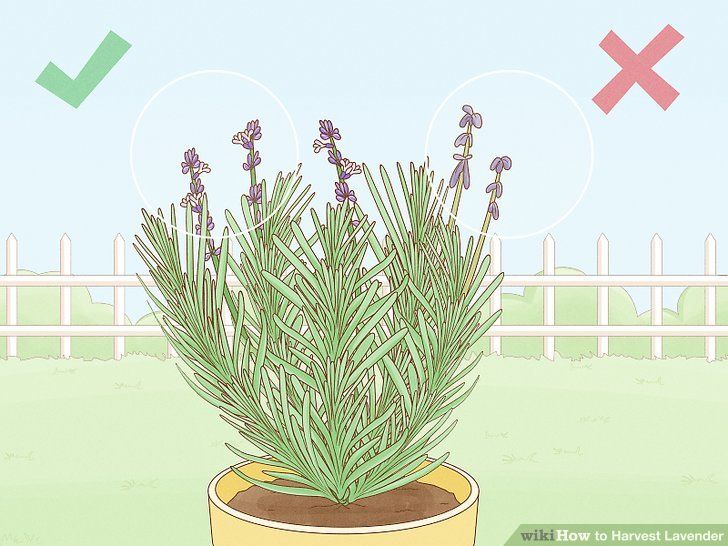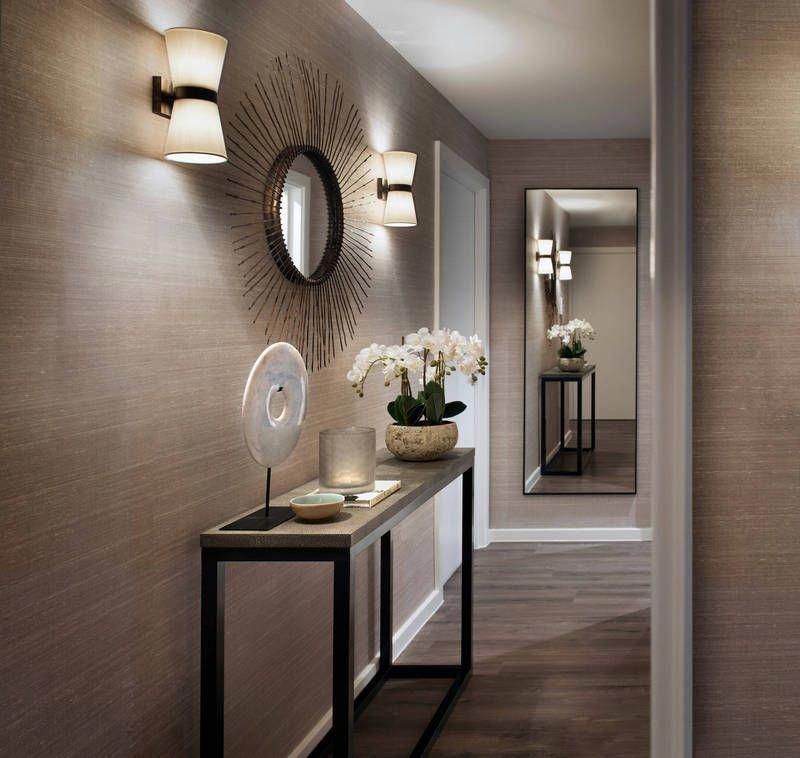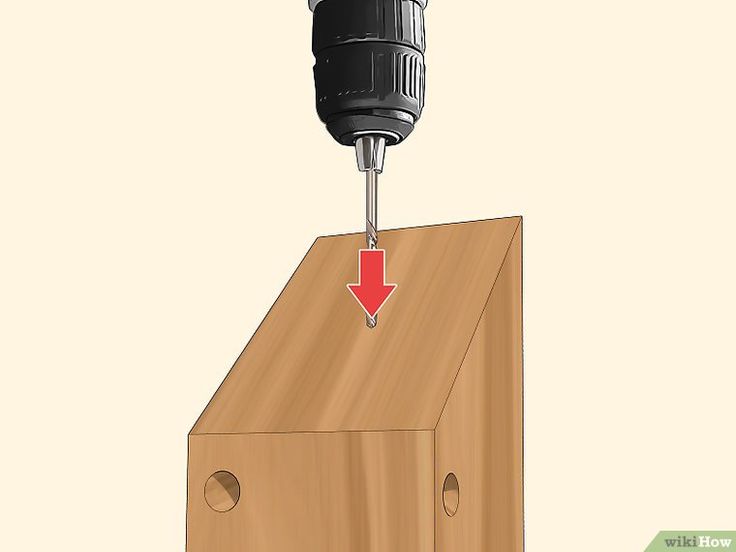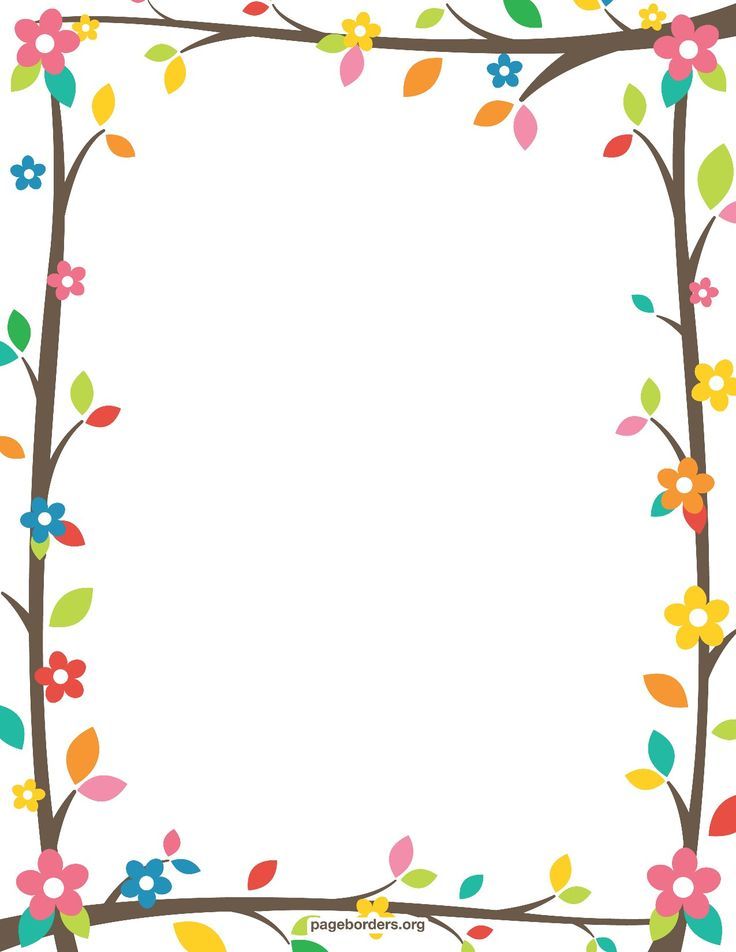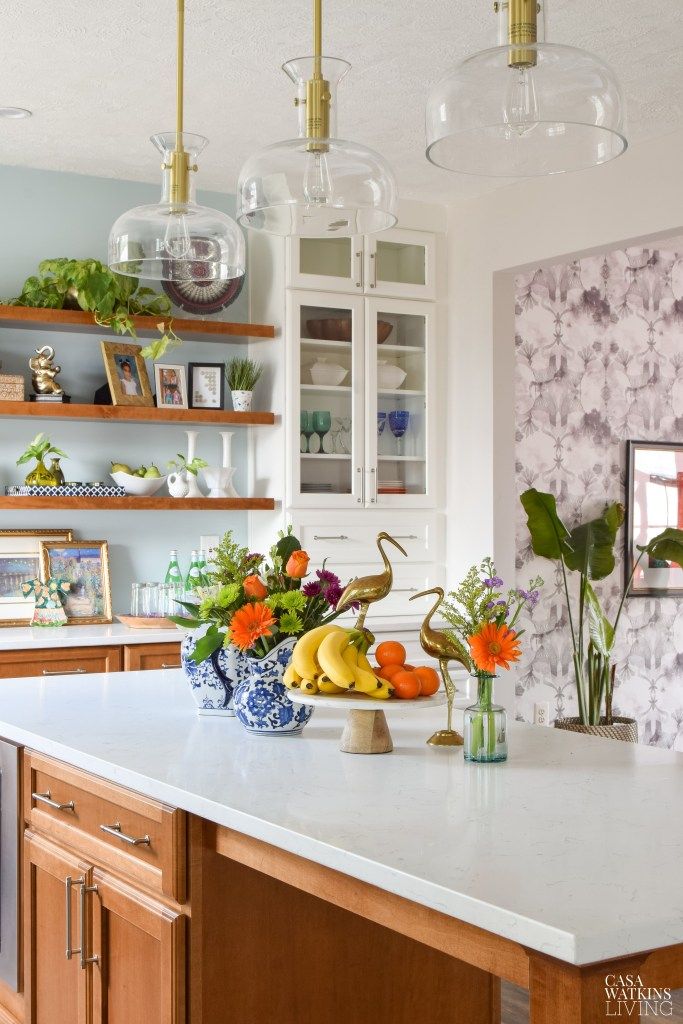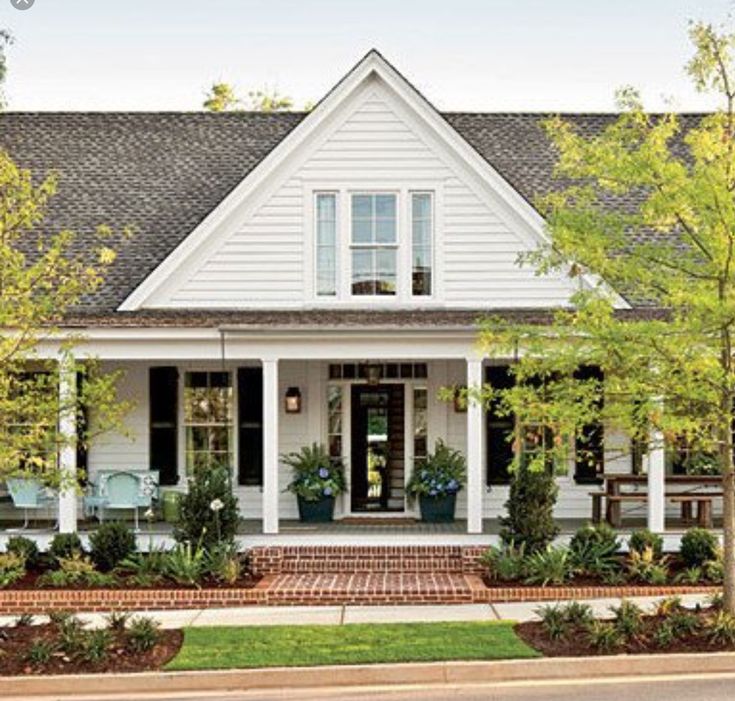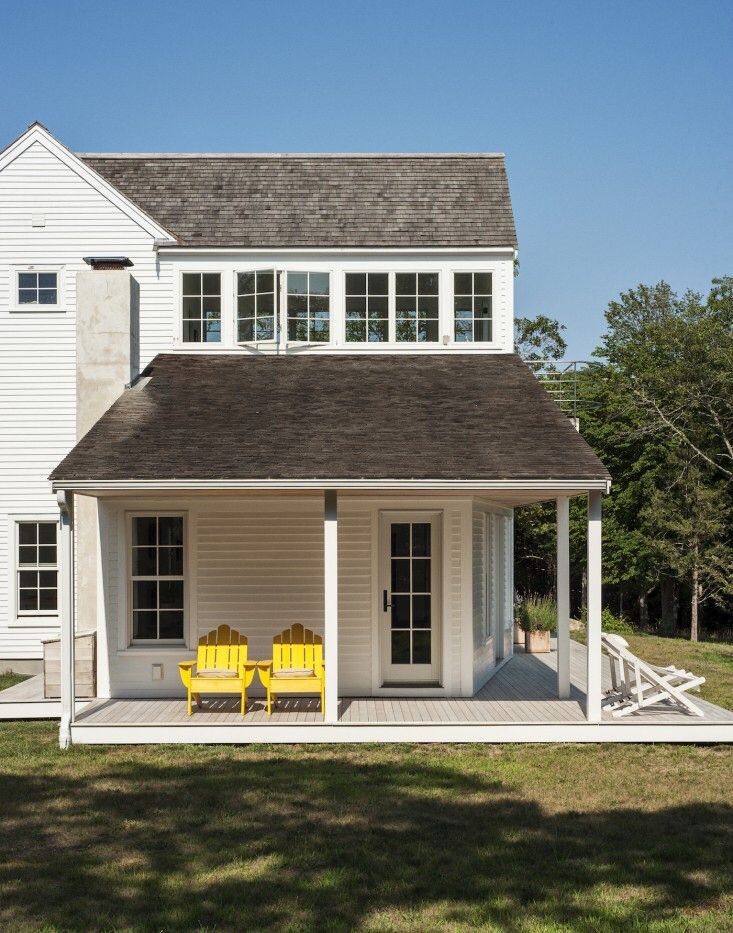Narrow garden design ideas
Narrow garden ideas: 12 clever ways to make the most of thin plots
Is your backyard long, thin, and crying out for a makeover? Then these narrow garden ideas are sure to come in handy.
In urban environments especially, they're one of the most common types of plot. But, it's easy to feel stuck when it comes to making one feel stylish. As you may already know, a narrow garden can feel 'boxed in', awkward, and shady. And, once you've factored in the plants as well as your outdoor seating solutions, it can feel even narrower than it did before – if you don't have a few tricks up your sleeve that is.
Good garden layout ideas and styling can make any space feel welcoming and chic, no matter its size or shape. And in this feature, we've rounded up plenty of ways to tackle a plot that's undeniably longer than it is wide. With these looks, you'll soon see that it's perfectly possible to turn a narrow space into the backyard of your dreams.
Narrow garden ideas: 12 stylish looks for your plot
From statement steps, stunning seating and show-stopping living walls (plus more), we've brought together some of our favorite narrow garden ideas below to help you get inspired.
1. Mix up the view by introducing levels
'The Habit of Living' garden, designed by Karen Tatlow and Katherine Hathaway for RHS Malvern Spring Festival 2019
(Image credit: Neil Hepworth/RHS)
One way to make a dull, narrow plot more interesting is to add tiered garden ideas. This will draw the eye upwards, helping to disguise that long, corridor-like look.
But, don't feel like you need to go for straight lines and angular shapes when playing with levels. Curved landscaping can have a more pleasing look and make the space seem wider. Take these steps, for instance, which wrap around a soft border full of beautiful blooms.
Position a seating spot on the higher level for the best views – and add some stylish garden screening ideas to boost the sense of privacy, should you need it. We also love how, in this plot, the statement bench is angled slightly to one side rather than lining up regimentally with the boundaries. This adds to the natural, flowing feel of the space.
2. Tuck in a pergola for stylish outdoor entertaining
'The Landform Garden Bar', designed by Rhiannon Williams for RHS Hampton Court Palace Garden Festival 2018
(Image credit: Neil Hepworth/RHS)
Love our pergola ideas? Don't let a narrow plot hold you back. Find a design that slots neatly into the farther end of your yard to shelter an outdoor bar or comfy corner sofa. Not only will it help to break up the length of your garden, but it will also provide an ideal spot for hosting guests.
If you're going for paving underfoot, go for a sleek, pale style to help expand on the feeling of space. It doesn't have to be one symmetrical stretch of stone either. Instead, you could offset two square sections of paving to create different 'zones' – this will help move the eye across the plot rather than down. Then, add plenty of plants around your plot's perimeter to cocoon it in vibrant color and foliage.
3. Pick functional pieces that work with the space
This narrow plot is full of good design choices
(Image credit: Matthew Williams/Future)
This narrow garden zone could be positively dreary if left to its own devices. But, clever styling and nifty furniture have transformed it into a welcoming and useable space.
But, clever styling and nifty furniture have transformed it into a welcoming and useable space.
First, note the stepping stone pavers, which offer a playful tone. Laid horizontally, they also distract from just how narrow the space really is. The table which sits above them features fold-out stools – an ingenious solution for dining alfresco in small garden ideas.
Potted plants and characterful sculptures bring an additional dose of personality to the plot, and we like the choice of door and window fittings too. Their glass panels mean that the line of sight isn't blocked even if they're left wide open, which offers a more airy and spacious feel.
4. Use a circular patio for a destination spot
The 'Jungle Fever' garden, designed by Pip Probert for RHS Flower Show Tatton Park 2018
(Image credit: RHS)
Remember how curves can help to widen a space? Bear this in mind when planning your patio ideas for your narrow plot.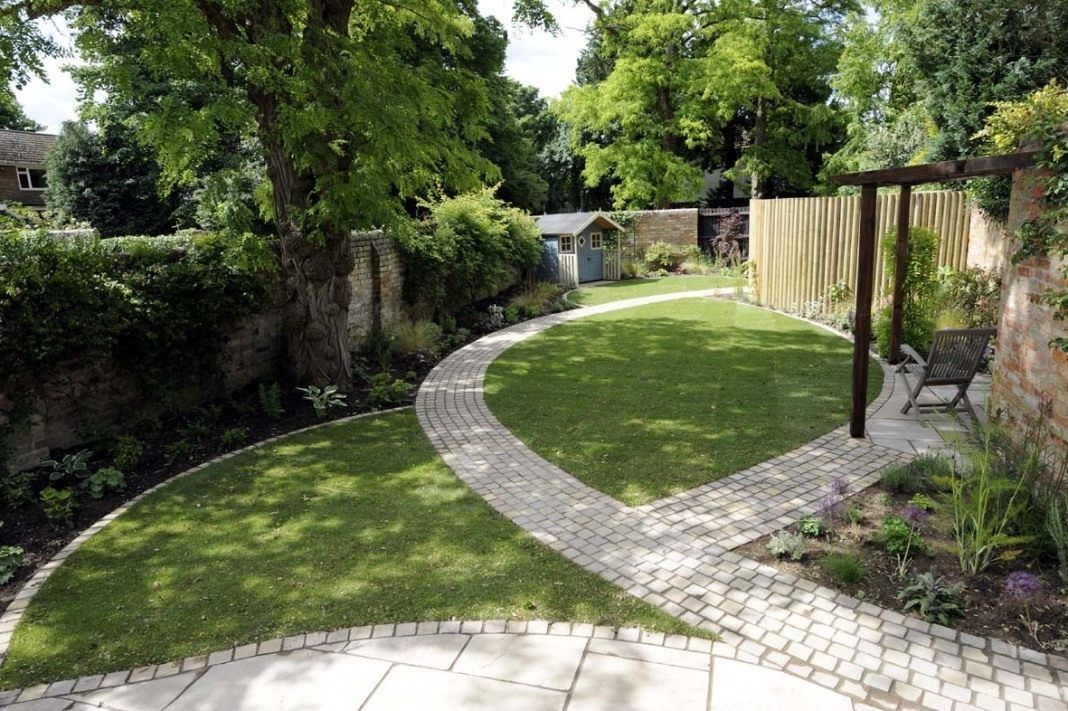 Take a look at this gorgeous design, for example.
Take a look at this gorgeous design, for example.
A sense of journey and intrigue is offered by the paved pathway, lined with sumptuous planting and defined further by a small pergola-style structure in modern black.
Beyond, the space opens out into a circular area of paving: a tucked-away retreat away from the hustle and bustle of the house. The contrast of this zone against the narrower path, as well as its curved shape, tricks the eye into believing the patio is more spacious than it really is.
To enhance a sense of cohesion, try mirroring the circular shape with a central fire pit for a toasty glow when night falls. This one doubles up as a useful table when covered with its lid – so it's a win-win.
5. Line a narrow deck with pots
A shade sail and lots of plants transform this narrow space
(Image credit: Future)
Working with narrow decking ideas? Here's a practical yet stylish solution. And, it won't cost the earth.
All you need is a good assortment of pots, planted up with your favorite blooms, to line the perimeter of the space.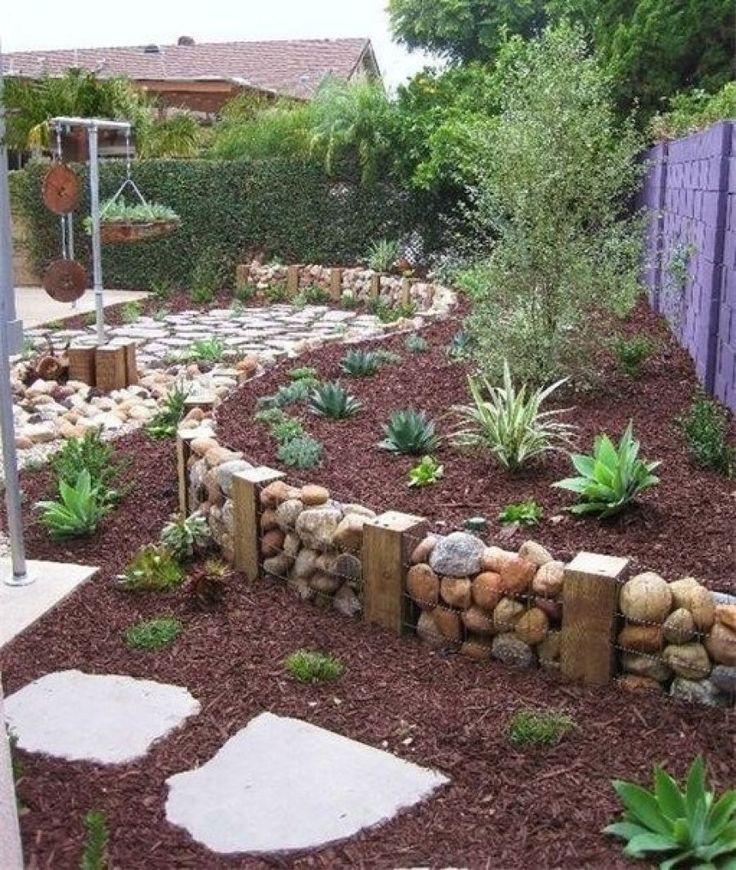 You could even pop some veggies in a few too, if you fancy a bit of grow-your-own action – lots will thrive in containers so growing vegetables in pots is definitely an option to consider.
You could even pop some veggies in a few too, if you fancy a bit of grow-your-own action – lots will thrive in containers so growing vegetables in pots is definitely an option to consider.
When it comes to furniture, opt for solutions that will help to maximize the space. Foldaway bistro sets are always useful as they're so versatile (and often, budget-friendly). Benches that double up as storage are also a good choice.
Don't forget the details up high, too – this will visually balance the scene. Think bunting and bird houses for a charming look. And, if you add a simple shade sail too, you'll be tempted to sit out in your narrow garden ideas even in the hot midday sun (or when it starts to rain).
6. Add gently curving pathways
A Japanese-inspired plot by Rhoda Maw Garden Design
(Image credit: Rhoda Maw Garden Design)
Garden path ideas are crucial for getting from A to B, but when it comes to narrow gardens, subtly meandering lines can be more visually pleasing than straight.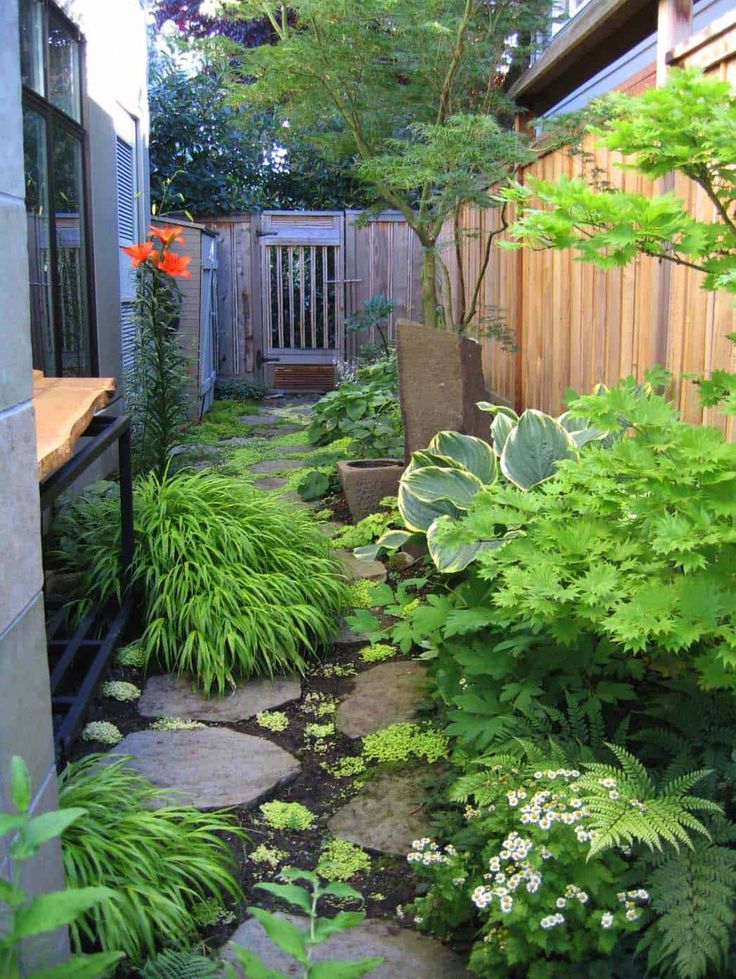 Take this design, for instance, where the central path gently curves side to side in an organic fashion.
Take this design, for instance, where the central path gently curves side to side in an organic fashion.
'This garden in Northolt had a very long, dark narrow section,' says garden designer Rhoda Maw . She explains how she visually widened it by removing the narrow strip of lawn to replace it with light pebbles across the whole width of the space.
'I also added rectangular pavers extending across the garden,' she adds, 'and the circular Moongate which also provides the illusion of more width.' We love the addition of acers too – a perfect choice for Japanese garden ideas.
Sometimes narrow garden ideas can be shady, especially if they're in a built-up area. But you can still make a walkway look fabulous with a little help from shade-loving plants. Wendy Smith, Garden Designer of The Plantsmith , recommends creating a cool walkway surrounded with lush green plants, including ferns and hostas, as well as the popular hydrangea 'Annabelle'. For even more of a verdant look, spread Soleirolia soleirolia opportunistically through the paving cracks, she adds.
7. Or, offset paths to and from garden zones
A central outdoor living space divides up this long and narrow garden
(Image credit: Rei Moon/Future)
Garden designer Wendy Smith also suggests how you can break up narrow garden ideas into zones. Use different hard landscaping elements and planting to mask the view so the end of the plot can't be fully seen, she says. 'A glimpse of a bench, for example, will give the user a reason to explore further.'
Offsetting a pathway adds width and interest, she continues. This scene above is a brilliant example, with stepping stones leading to and from a chic outdoor living 'room'. If you're also after long garden ideas, a design like this is definitely one to consider.
8. Shelter a central seating area
Break up your plot with statement structures
(Image credit: Charlie Hopkinson/Future)
'Narrow sites are challenging, of course. However, as always, challenges bring opportunities,' says John Wyer, CEO of Bowles & Wyer .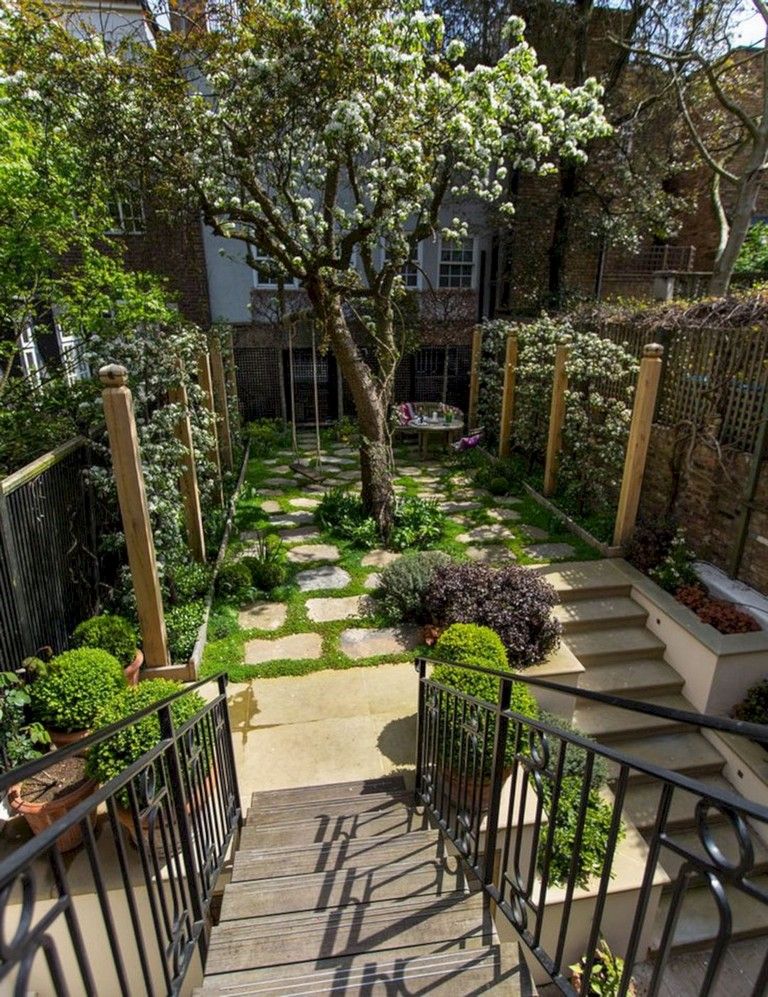
'One of the things I like about long, thin plots is the opportunity for stretching the perception of the space. Dividing the plot up into smaller blocks means that you can rarely see everything from the outset. This means that there is a necessity to explore – what is just beyond that hedge or trellis or bush?'
One way to do this is by breaking up your plot into three, using patio cover ideas or gardening screening ideas to define the middle section. This could be as simple as a large garden parasol or a length of trellis, but there are plenty of bolder options if you really want to make a statement (and have a bit more budget to spend). Take this chic metal shelter, for instance – ideal for a contemporary plot and the perfect backdrop for jewel-hued blooms.
9. Create drama with a living wall
A foliage-filled wall draws the eye
(Image credit: Alun Callender/Future)
When it comes to your narrow garden ideas, 'Think vertically,' as says garden designer Wendy Smith.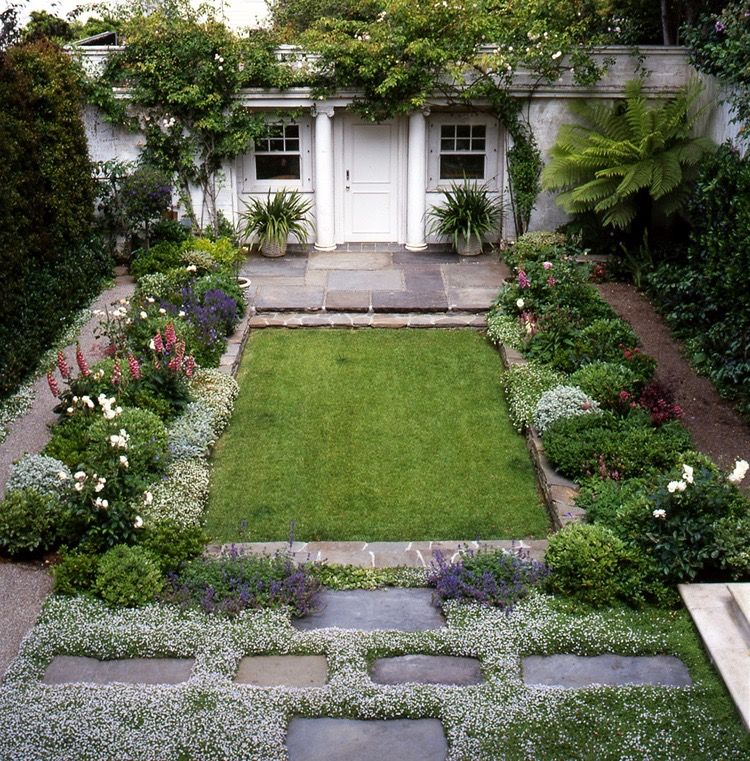 There are so many great green wall systems available, she adds.
There are so many great green wall systems available, she adds.
Not only will a living wall allow you to bring tons more greenery into smaller plots, it will also add a real sense of drama. And, if you use it on the farthest wall, it will encourage you to look upwards, taking the focus away from the narrowness of the space.
10. Reflect the scene with mirrors
We love the addition of mirrors to the fence in this garden by Tom Howard Garden Design
(Image credit: Tom Howard Garden Design)
Garden mirrors make wonderful features for all manner of plots. Not only are they useful in pepping up blank walls or fences, but they also double up the view and bounce the light around, helping a space feel bigger and brighter.
For a stunning look, take a cue from this set-up above by Tom Howard Garden Design and position mirrors along the length of your fences to the side of your plot. It will provide a ton of visual interest, especially if you plant a luscious border in front.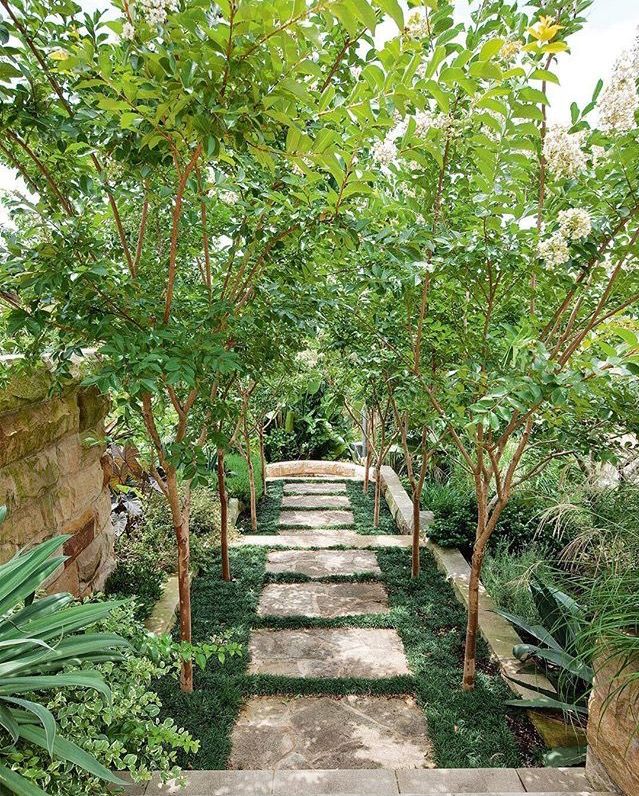
11. Opt for a pared-down palette
A pale color scheme sets a fuss-free yet modern tone
(Image credit: Mark Bolton Photography/Future)
If you're looking for courtyard garden ideas as well as narrow garden ideas, then a set-up like this might be the way forward. It's easy for this kind of space to feel 'boxed in' due to the tall, imposing walls, but there are still some simple tips you can try.
Opting for a neutral palette of pale stone and timber can help to brighten the space and set a fuss-free yet contemporary tone. Alongside this, a few large planters can be all that's needed to create an impact (and will be low-maintenance, too). Try sculptural topiary with evergreen shrubs or a large olive tree for reliable texture and greenery all year round.
12. Choose streamlined seating
A sleek seating spot designed by Tom Howard Garden Design
(Image credit: Tom Howard Garden Design)
Taking a streamlined approach to outdoor seating ideas can be a good option when it comes to thin gardens.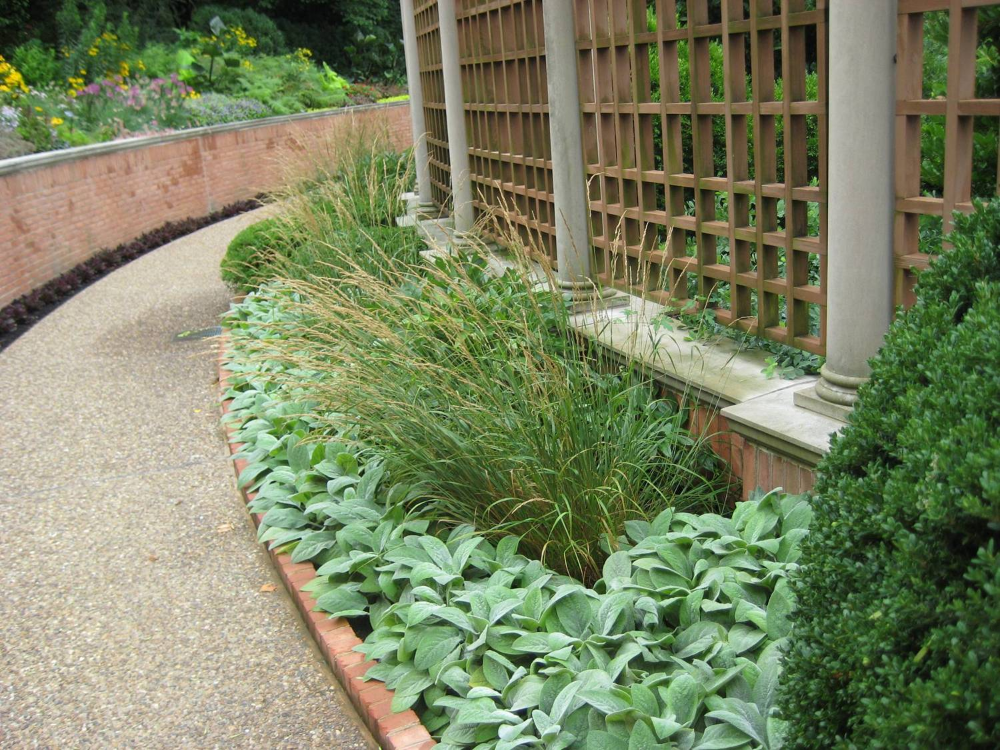 This cuts down on clutter – resulting in a clean and more spacious look: ideal when dealing with smaller plots.
This cuts down on clutter – resulting in a clean and more spacious look: ideal when dealing with smaller plots.
One way to do so is to use the walls of bordering raised beds to support floating benches – just like in this design by garden designer Tom Howard. It will provide ample room to entertain guests against a pleasing backdrop of flowers and foliage, and looks super-stylish too.
You can add in extra accessories to boost the cozy factor should you wish – think comfy cushions and a garden rug underfoot for a real sense of outdoor living. Fold-up tray tables can also be a useful addition for placing a cuppa and a book when needed.
What can you do with a narrow garden? More top tips
Corten steel and beautiful agapanthus line the borders of this garden by Bowles & Wyer
(Image credit: Bowles & Wyer)
So we've covered mirrors, levels, curved landscaping, colors and more, and hopefully by now you're feeling inspired for your own narrow garden ideas.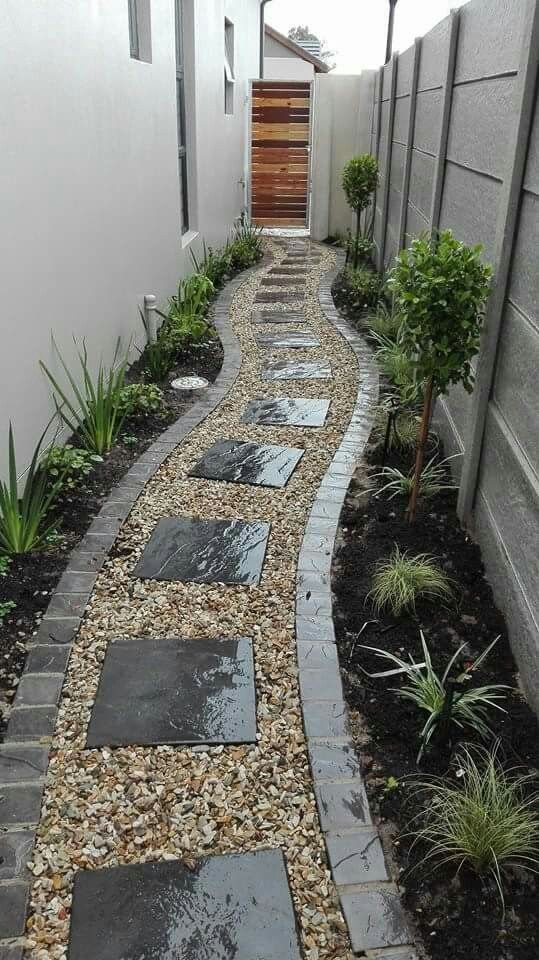 However, there are even more things you can try to make the most of your space.
However, there are even more things you can try to make the most of your space.
When it comes to breaking up a plot into smaller sections, John Wyer, CEO of Bowles & Wyer, says how outdoor lighting ideas can play a key part.
For example, different lighting solutions can help to determine the ambience and purpose of different zones – think gentle festoons for outdoor seating, brighter lights for outdoor kitchens, or a hanging pendant over a sheltered outdoor dining space, for instance.
'The other thing about slender spaces is that the boundaries play a much greater part,' John adds. He sees them as great opportunities, from trellises and old brick garden wall ideas to colored render or as vehicles for supporting scented climbing plants. 'Have fun with the space!' he says.
What can you plant in a long narrow garden bed?
Try alliums in a thin border for vibrant color and structure
(Image credit: Clive Nichols/Corbis Documentary/Getty Images)
If you've lined your narrow garden ideas with flowerbeds, then you might be wondering what you can plant in them.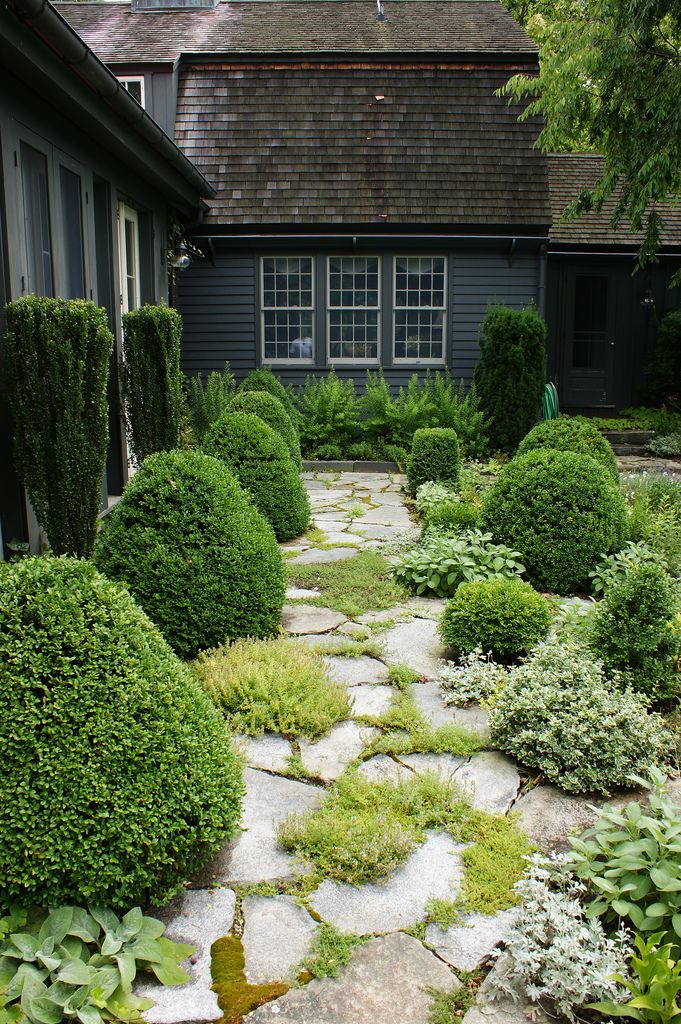 Taller varieties are a good bet as they'll help disguise the boundaries, whilst picking a cohesive color scheme will prevent the look from feeling fussy and chaotic.
Taller varieties are a good bet as they'll help disguise the boundaries, whilst picking a cohesive color scheme will prevent the look from feeling fussy and chaotic.
We've rounded up some of our top choices:
- Clematis is a beautiful climbing plant that clambers up walls and offers prolific blooms. It's a lovely choice along the back of narrow borders – our guide on how to grow clematis is full of useful tips.
- Alliums offer playful structure with their vivid purple (or white) globe-shaped flower heads. They're also one of our picks for the best plants for beginners.
- Espalier trees are an elegant choice and as they're trained flat along a wall or fence, don't take up much room. Try apple or pear for beautiful blossom in spring and a delicious harvest in fall.
- Verbena bonariensis with its tall, structural stems topped with clusters of violet blooms is a lovely pick for narrow borders, and pollinators adore it.

- Japanese anemones are prolific and easy to grow, thriving in both sun and shade. They flower from midsummer right up until the end of fall.
- Ferns make a lovely choice for modern plots and create a jungle-like vibe. Most prefer to be planted in dappled shade – our guide on how to grow ferns has more advice.
28 Landscaping Ideas for Long and Narrow Gardens
Search
Try these best
Landscaping Ideas for Long and Narrow Gardens to make the best use of limited space and make it appear large and beautiful!Do not let the small space in your yard stop you from adding a bit of appeal to the space. Here are some amazing Landscaping Ideas for Long and Narrow Gardens to help you out!
Check out some awesome vertical gardening ideas for small gardens hereLandscaping Ideas for Long and Narrow Gardens
1.
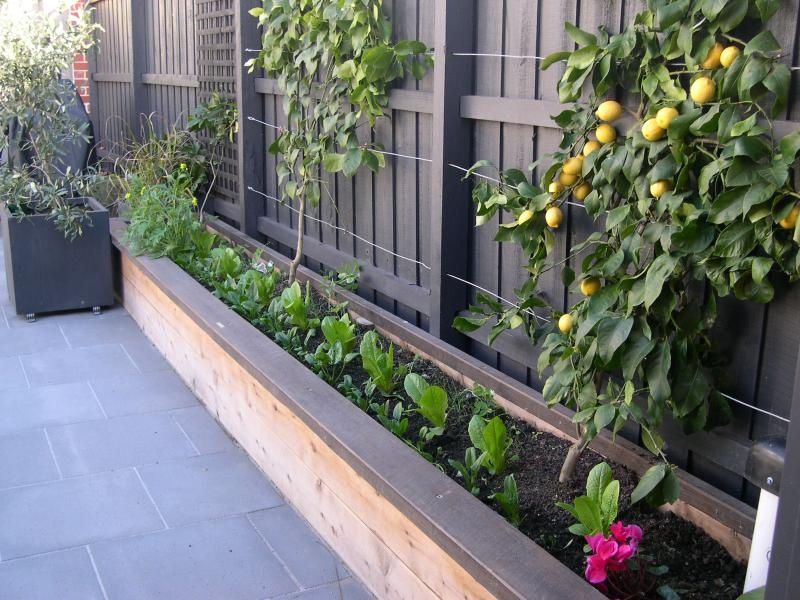 Grow Tall Trees to Add Depthhoustonlandscapes
Grow Tall Trees to Add DepthhoustonlandscapesGrowing tall trees amidst the groundcovers will add more depth to the bland landscape. Also, you may opt for stone paving with grass in between.
2. Grow Circular Patches of Lush Grasslands
Circular patches of grassy land bordered by brick walkways make narrow gardens appear wider. To make it more appealing, you may also add blooming groundcovers and shrubs.
3. Line Potted Plants by the Yard Fence
Line beautiful potted plants along the fence to use the corner space. You can also fill the garden with narrow plants which won’t spread much.
4. Hang Flowers Baskets and Creepers on the Wall
Hang flower baskets, install raised beds, grow blooming groundcovers, and train creepers to give your long and narrow garden an attractive look.
5. Plan an Urban Jungle with Tropical Plants and Large Boulders
Invite tropical vibes in your garden with lush foliage plants like Aglaonema, Palms, Bananas, and Agave.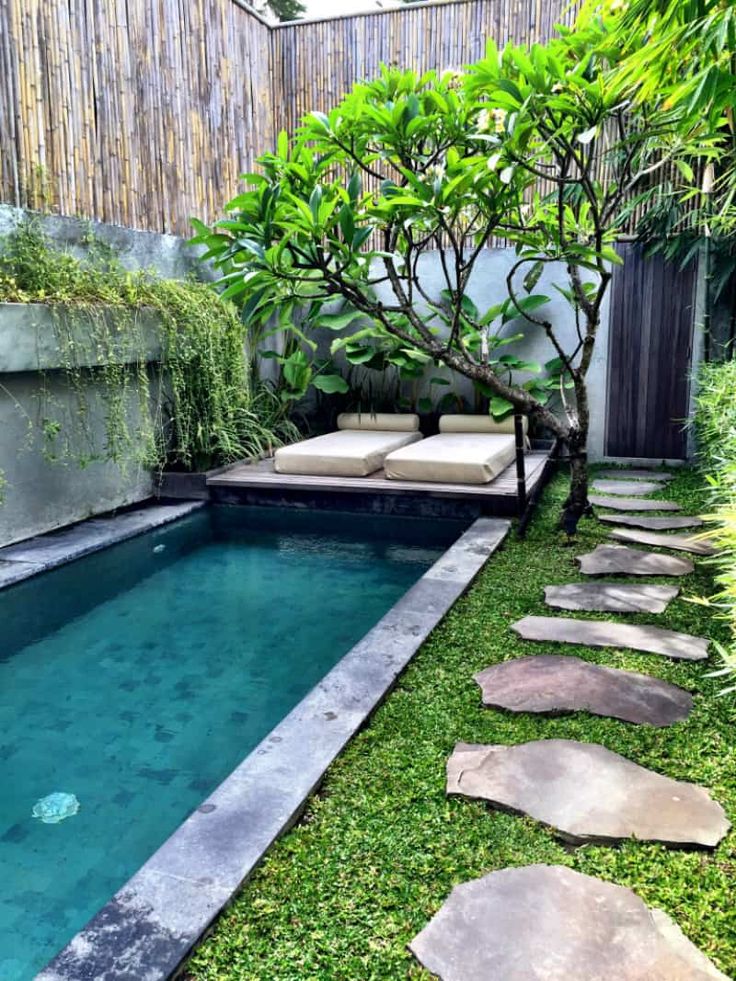 You may also add large boulders to complete the look.
You may also add large boulders to complete the look.
6. Add a Pop of Colors with Vivid Foliage Plants
A long, narrow garden can benefit from the choicest play of colors with variegated plants. You can also add some flowers in between to enhance the appeal.
Discover the most colorful houseplants here7. Divide into Sections
Divide your yard into grassland, gravel bed, and tiles sections to make the small area look appealing. Grow bushy groundcovers along the edges and set up a small dining place to relax.
8. A Beautiful Private Garden!
gardensillustratedDesign a beautiful private garden with a lush turf bed, sandstone paving, tall bushes, and a quiet sitting arrangement.
9. Hide the Sitting Space with a Clever Landscaping
Plan a clever landscape to keep your sitting deck private. Grow the tall trees and potted plants wisely along the fence to level up the aesthetics.
10. Plan a Grassless Courtyard with Pebbles and Paving Stones
Grassy courtyards require more maintenance.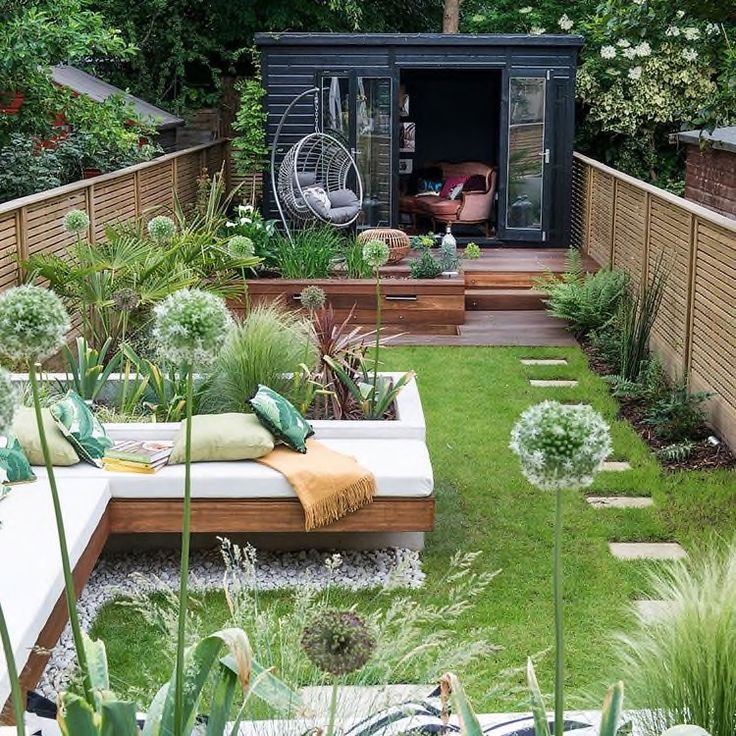 Save your time and energy by introducing a pebble walkway and sandstone paving to give your narrow yard a much-needed makeover.
Save your time and energy by introducing a pebble walkway and sandstone paving to give your narrow yard a much-needed makeover.
11. Grow Raised Beds on Either Side
Grow raised beds to make the most of the limited space in the yard. Also, plant big trees to create a shady canopy along with other potted varieties.
12. Plot a Tiered Yardscape
A tiered landscape makes for a contemporary look. Utilize the long yard to create a bonfire at the center and border the edges with a succulent bed.
13. Design a Raised Urban Lawn with Pavings
A perfect landscaping idea for city dwellers! You can also install colorful fencing for an added charm.
Find out some beautiful urban garden ideas here14. Don’t Go For a Single Path
Opting for a single path is not a good idea for long and narrow gardens—going for more than one path will deflect the attention.
Find out some formal garden design ideas here15.
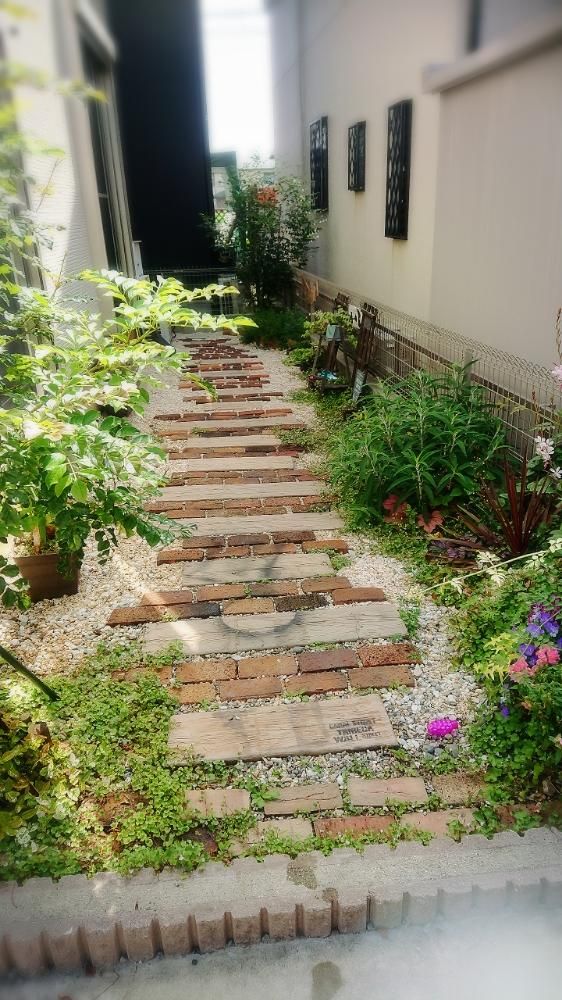 Divide the Garden into Different Sections
Divide the Garden into Different SectionsBreak the garden space and make different sections. Use plants and structures for creating screens. Install trellises and pergolas; create decks, paths, and paving.
16. Add a Water Feature
You can create a water feature in your long garden to eliminate the city sound. It will not only soften the noise but also look calm and soothing.
17. Make Different Garden Zones for Various Uses
Divide the garden into different zones. Develop the first for enjoying coffee and conversation, second for the sunken garden, and the third as a screened eating or entertainment area.
18. Choose Climbers Over Hedges
EnredaderaIf your narrow garden has boring walls, borders, or ugly fences, install trellises with climbing plants. This vertical garden-like arrangement will create more growing space.
Look at the best shade-loving flowering vines here19. Paint in Cool Shades
While planning the narrow gardens, don’t overlook the walls and fences as they are very dominant to the view.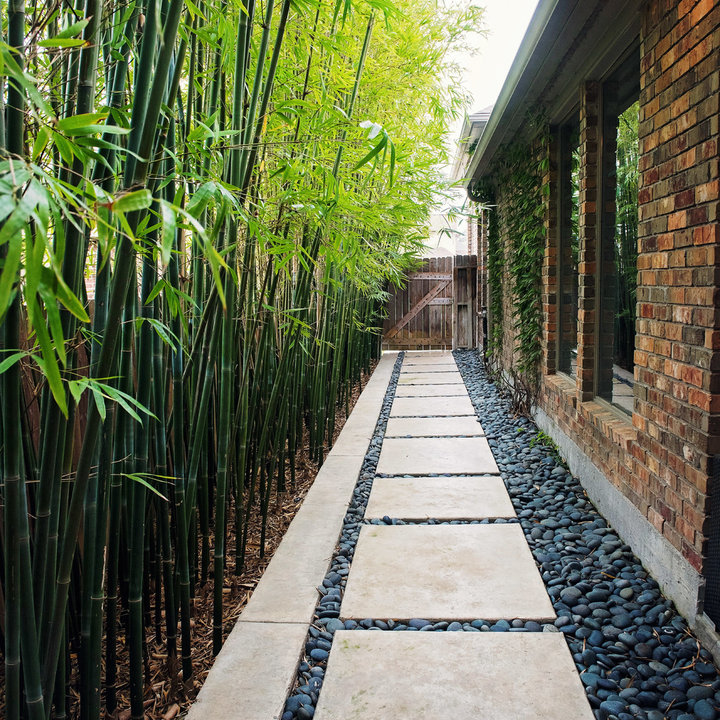 If the area is small, always go for cool and bright shades.
If the area is small, always go for cool and bright shades.
20. Build Screen Using Plants
greenleafipsDo not use solid barriers in narrow spaces—instead, opt for vertical planting and trellises. You can also utilize the walls.
21. Use Hard Landscaping to Add Zones
You can add zones in long gardens by using hard landscaping. Build raised beds and sitting areas that cut into the space—this will make it appear wider.
22. Use Ornamental Grasses
Tall arching ornamental grasses create mesmerizing effects in your narrow gardens. You can grow varieties like Miscanthus, Molinia, and Stipa.
Look at the most stunning ornamental grasses here23. Raise a Seating Area at the End of Your Garden
Position a seating area at the end of the landscape—the height will divulge the long line of view. You can also add tall shrubs to add a subtle screen.
24. Use Mirrors
Mirrors are an apt choice to make the space look bigger and reflect light into your long garden.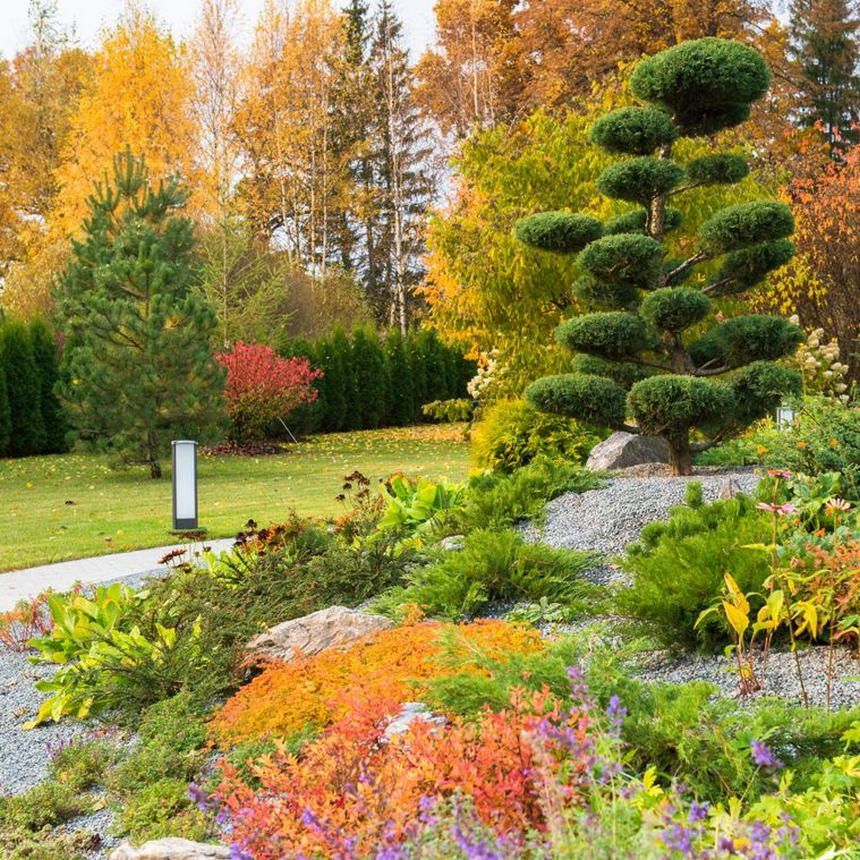 Install a big one on a fence or wall as a focal point.
Install a big one on a fence or wall as a focal point.
25. Set Bright Furniture
Add an aesthetic piece of outdoor furniture like a garden bench in your yard. It will make the narrow space look really dramatic!
26. Use Curves to Break the Long Lines
A twisting pathway is a good trick to break up the narrow lines. Round and curved shapes in a long and narrow plot make the space more natural and attractive.
27. Boost the Curb Appeal with Groundcovers and Creepers
Grow patches of groundcovers and creepers to complement the brick paving in the yard. You can also introduce a circular stairway to add a contemporary appeal to the overall look.
Look at some cheap ways to boost the curb appeal of your yard here28. Pave an Asymmetric Concrete Walkway in the Yard
Concrete walkways look welcoming amidst a grassy yard covered with low-growing bushes. Pave the tiles asymmetrically to add more drama.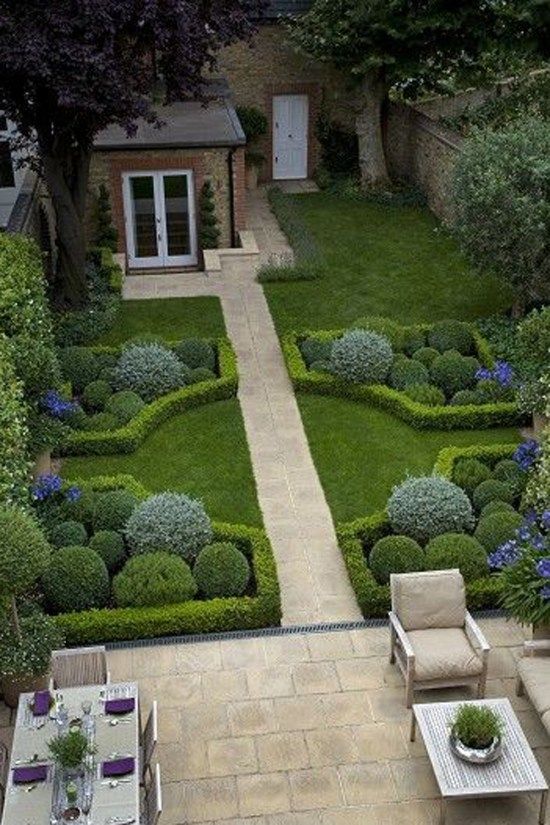
Join our 2.8 Million Followers
Social Followers
2.5MFollowers
219kFans
36kSubscribers
YouTube
Design of a narrow plot: layout options for a narrow long plot
An elongated elongated rectangle - literally a strip of land - is a fairly common form of land plots. They are often obtained by combining two plots in gardening, or go "to the fields" in the villages. And if a solid plot adjoins the townhouse, then, most likely, it will be of just such a shape. We are studying possible design options for a long and narrow garden plot.
BraytonHughes Design Studios
The layout of a long and narrow plot, the location of the house on it will depend on which side the entrance is organized from. And this, in turn, depends on the location of access roads and the layout of the area.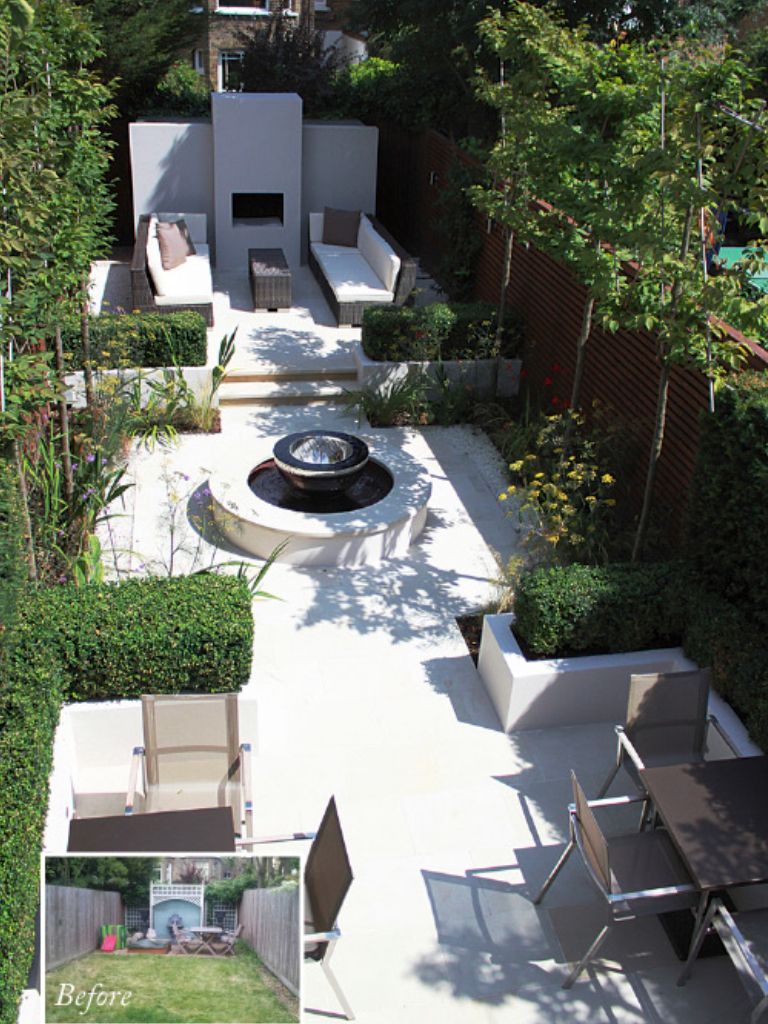 It is good if the roads adjoin two boundaries of the site: as a rule, these are its two short sides, or this happens in the case of a corner location.
It is good if the roads adjoin two boundaries of the site: as a rule, these are its two short sides, or this happens in the case of a corner location.
Travushka.ru
Important: One of the possible disadvantages of a narrow long area is shading - from buildings, their own and neighbors, from high fences. It is advisable to take this factor into account already at the stage of purchasing a site and when planning it. For such allotments, the location on the cardinal points is especially important. It is optimal if the site is stretched from east to west, and one of the long sides is oriented to the south.
READ ON TOPICS…
My sun: How to make a plan for a summer cottage based on the movement of the sun
GreenHeart, LLC
the narrow side of the long section is excellent: we separate the front part from the private part.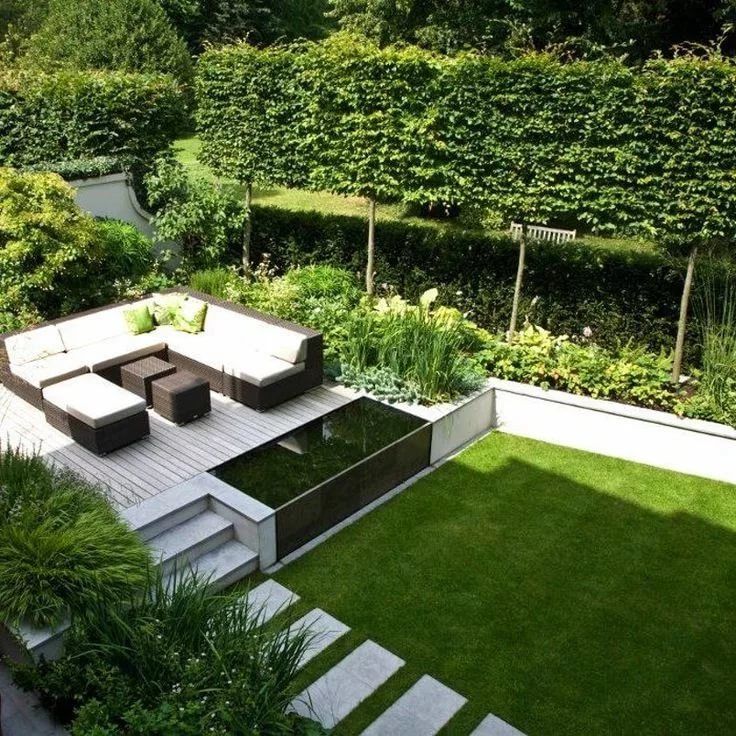 Their boundary and natural transition zone will be the house. In the front part, in front of the house, the entrance zone is logically obtained, and the rest of the content remains in the back of the site.
Their boundary and natural transition zone will be the house. In the front part, in front of the house, the entrance zone is logically obtained, and the rest of the content remains in the back of the site.
Front entrance in front of the house will open your property to the street. Do not use absolutely all the landscape techniques that you like here: depending on the chosen style, compositions from cut shrubs will be appropriate, or one large bush with an expressive shape and flowering.
Agricultural Services
If you prefer classical symmetry, place two medium-sized shrubs on the sides of the entrance to the house - it, of course, in this case will be in the center. Maintaining their shape will need attention, even if you don't plan on turning them into complex topiary shapes. Otherwise, you may end up with an image of an old overgrown dacha. If this is exactly what you are striving for, feel free to plant a lush lilac, viburnum or mock orange.
In general, the entrance area can be left quite open with this placement, even if the rest of the site is enclosed by a solid fence. This does not mean that there will be no fencing at all, but openwork lattices and low hedges can be used here.
Tim Davies Landscaping | Perth
A clear separation of the front and private areas, their visual and actual isolation make it possible to implement multi-style solutions on one, even a small area. The entrance area can be arranged in the form of a regular parterre with its inherent attributes - lace patterns from the lawn or miniature shrubs, flower borders and topiary figures. Sculpture, classical, or, on the contrary, avant-garde, will also come in handy here. The private part of the plot, located behind the house, can in this case be solved in a more free spirit.
Harold Leidner Landscape Architects
This separation does not mean that parts of the site will only be connected through the house.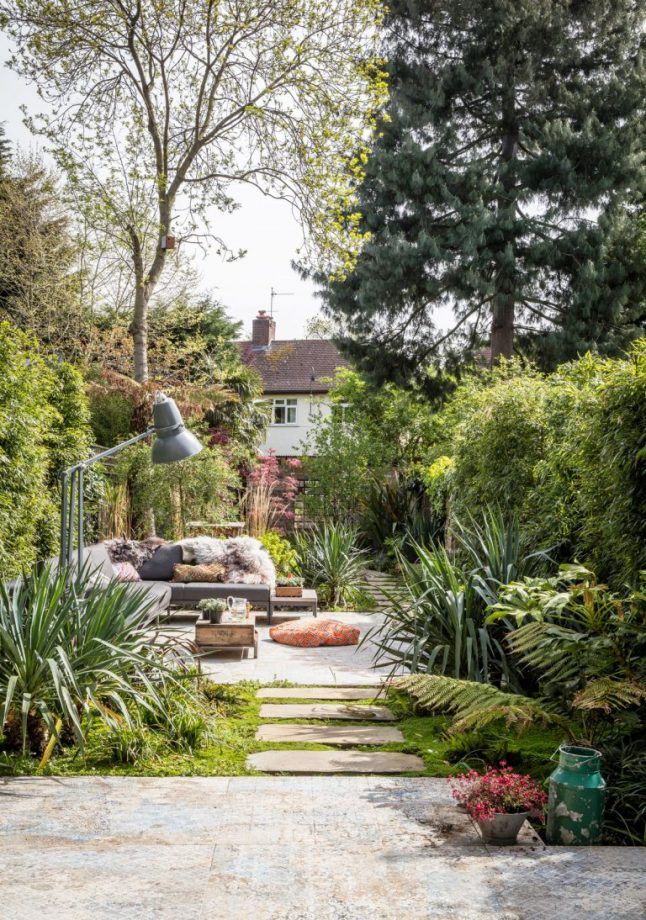 Firstly, do not forget about safety standards - the house, if it is not a continuous building, should not adjoin closely to the fence. On its sides it is necessary to leave technical passages. With a similar arrangement, they will be quite narrow and long. They can be decorated with pergolas and decorative lamps. Also, with such a layout of a narrow section, for security reasons, it is worth organizing a second exit from the site - in its rear part.
Firstly, do not forget about safety standards - the house, if it is not a continuous building, should not adjoin closely to the fence. On its sides it is necessary to leave technical passages. With a similar arrangement, they will be quite narrow and long. They can be decorated with pergolas and decorative lamps. Also, with such a layout of a narrow section, for security reasons, it is worth organizing a second exit from the site - in its rear part.
SEE ALSO…
Scenic Gorge: Design solutions for bottlenecks on the site
The entrance area in this site layout most often has to be placed in front, shifting it to one of the side borders. If you still want symmetry, create it by placing plants on the rest of the site. In the center, draw a straight path to the porch, limiting it to the sides with flower borders. And in front of the house, leave a platform along the entire facade, connecting it with the parking area and side passages to the far private part of the site.
Affecting Spaces Design Studio
All other functional areas will be located behind the house. Since the width of the site is small, they should be placed sequentially, moving away from the house as the use is active. Immediately behind the house, it is advisable to place a recreation area - as in the photo, a summer dining room and a children's playground. Then - a vegetable garden, a garden and economic zones. Some of the greens can be placed in containers next to the summer dining room so that they are at hand.
Ascher Smith
Garden trees can be arranged:
- in a row along the perimeter of the plot - in this case, they will help to create a not too decorative fence;
- group them in the far part - they will create a green accent and visually make the area less elongated, dissolving its border;
- or use them as a buffer zone to further subdivide the site.
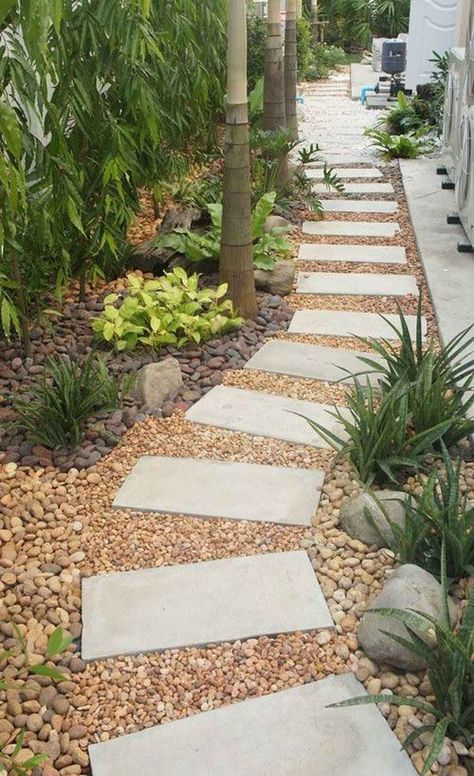
Aralia: Innovation in Landscape Design
If possible, in the far part of the site you can arrange another secluded recreation area - a small gazebo, or just a bench surrounded by beautiful flowering shrubs.
Ekaterina Lieberman
Option 2: Entrance from the end, but the house is oriented along a narrow plot
several functional areas.
Fork Garden Design
An elongated entrance area will appear on the side of the house, leading deep into the plot. In this case, it is convenient to place the entrance platform and parking at the very beginning of the site, in front of the end of the house. Visually, high gates and plants will help protect it. A beautiful light canopy will make the parking lot more functional and replace the garage for temporary car parking if you visit the country house only on short trips.
The area behind the far end of the house, covering the entire width of the plot, is a great place for a recreation area and a barbecue. In the far part of the site, place a garden and economic zones. It can be separated from the "residential" space by beautifully designed outbuildings - a barn, greenhouses, a summer kitchen. Or plant a small garden here. Trees or buildings will act as a screen dividing the site into two parts. READ ALSO…0019
In the far part of the site, place a garden and economic zones. It can be separated from the "residential" space by beautifully designed outbuildings - a barn, greenhouses, a summer kitchen. Or plant a small garden here. Trees or buildings will act as a screen dividing the site into two parts. READ ALSO…0019
Dane Spencer Landscape Architecture
Landscaping Solutions
Tip: When designing a narrow lot, don't be afraid to use real screens. On a long section, they are more than appropriate - they help to zone an extended space and visually compensate for its overly elongated shape. Narrow enclosing elements - they can be hedges, shrubs, climbing plants on a trellis, light fences, vertical tiered containers for plants - will help to highlight backstage corners. In such a place it is good to place a miniature recreation area with armchairs, a dining group, or to hide a utility platform behind them.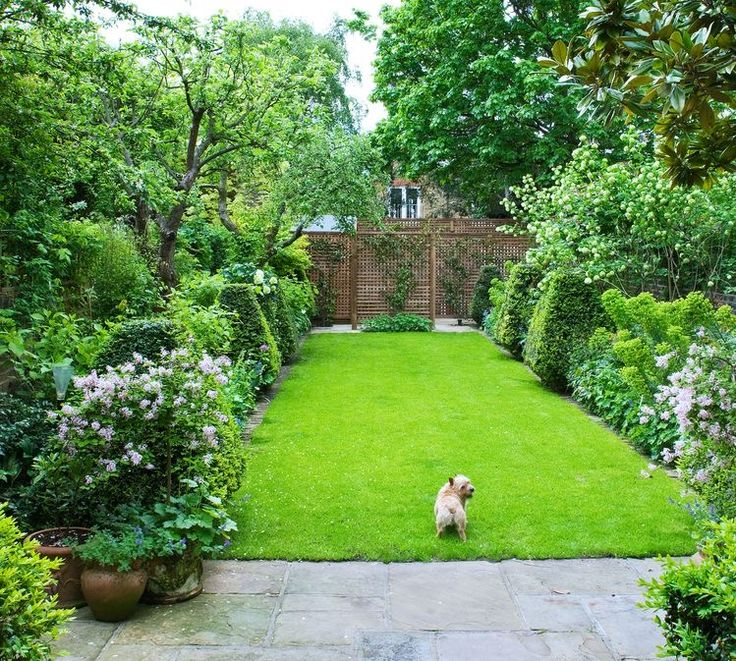 Due to the presence of isolated zones and fragmentation of space, the site will appear larger.
Due to the presence of isolated zones and fragmentation of space, the site will appear larger.
Archiverde Landscape Architecture
Option 3: Entrance on the long side of a narrow lot
If your extended lot extends along your driveway, this gives you more room for zoning. Again, home placement will help us with this. By placing it in the center of the site, you divide the space into two fairly separate zones, additionally getting a small space for the entrance area in front of it and a narrow plot of land behind it.
Freiraumplus
Acanthus Design-Denise Woolery
The layout of the long plot with the central position of the house allows you to clearly separate the "living" area with outdoor dining, barbecue and sun loungers, and the utility area - vegetable garden, orchard, sheds and greenhouses. They fit perfectly on both sides of the house. Since this way the site is divided into almost square zones, it will be easier to place equipment on each of them.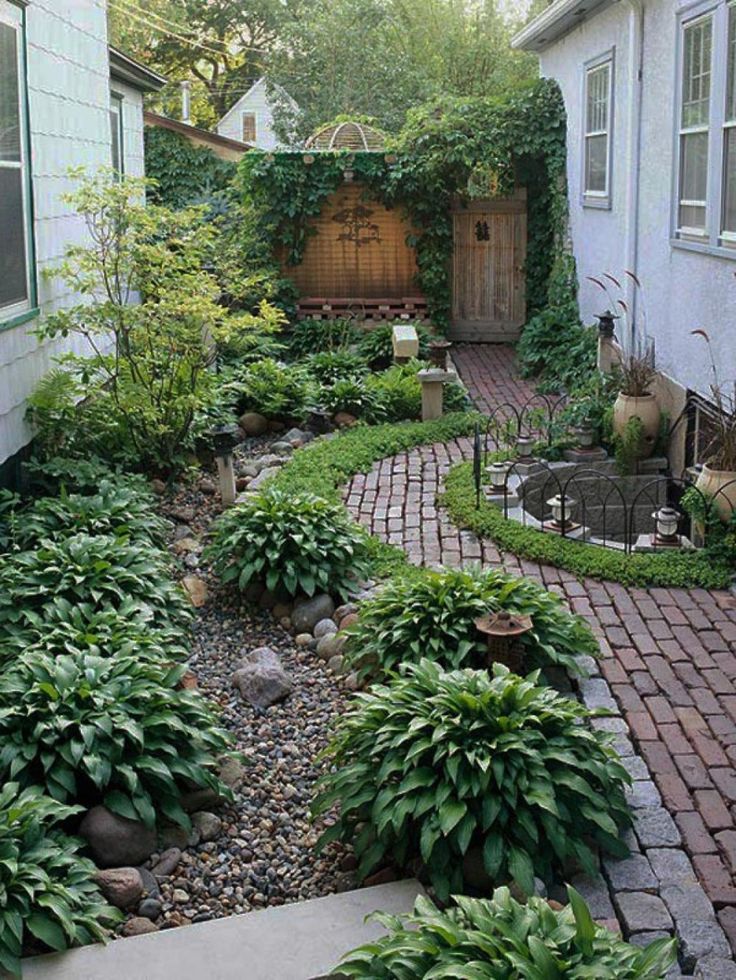
PLACE architect ltd.
If, with such an arrangement of the entrance, the house is moved to one of the short borders of the site, this will allow organizing parking and a utility site in this part. And plan the rest of the space, like the first design option for a narrow section.
Pocknell Studio
What Plants to Grow in a Narrow Lot
For not too big stretches, trellis trees and compact stem forms are ideal. They will help in zoning if used as visually light screens. In the same capacity, climbing plants on a trellis can be used. Trellised tree growing is ideal for narrow gardens due to the flat shape of the plants. Such a garden can be placed along the boundaries of an elongated area. In order not to visually increase the length of the fence, form trees in the form of palmettes with diagonal and vertical branches.
READ MORE…
Trellis in the Garden: How to Grow Odd Shaped Trees
Don't forget about container growing, too, as it will help compactly place both ornamental and garden plants.
However, lush shrubs in a narrow space should not be neglected. They will perfectly dissolve the far border of the site, making it visually more harmonious. They will also help in zoning, dividing different parts of the site.
Green Tree Garden Design Ltd
How to visually compensate for the elongated shape of a narrow area
1. Zone - a clear division into zones draws attention to the shape of a separate site and distracts from the overall shape of the site. As separators, you can use both various screens that give backstage closeness, and open zoning tools - paving, flower borders, clipped shrubs. They will help to divide the space into plans, making it more diverse and giving the eye clues at different distances.
READ MORE…
Zoning the lot: 11 steps, not counting the fence
John Davies Landscape
If you want a body of water but think the shape of the lot won't allow it, be bold.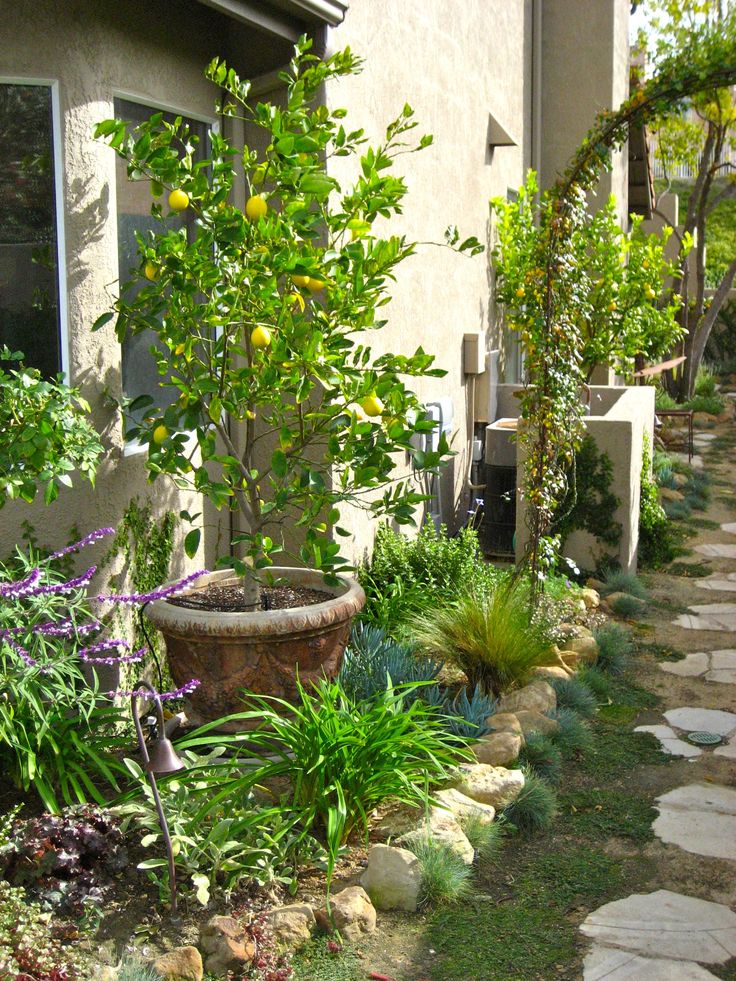 A narrow body of water - a stream or a geometric pond - will perfectly help in zoning a long narrow section. An alternative would be a dry stream.
A narrow body of water - a stream or a geometric pond - will perfectly help in zoning a long narrow section. An alternative would be a dry stream.
READ MORE…0018 what is important to know
Kate Eyre Garden Design
2. Use relief - natural relief or artificially created, terracing will help in zoning and compensate for the small width of the site. Especially if the terraces are not straight and placed not strictly across the site.
SEE ALSO…
Over the mountains, over the valleys: How to take advantage of the terrain
Private Gardens, Public Places
3. Distract attention - When designing the area, use curved and broken lines in the form of paths and playgrounds. This will distract from the elongated shape of the site. For an additional effect, move the platforms relative to each other, combine different sizes.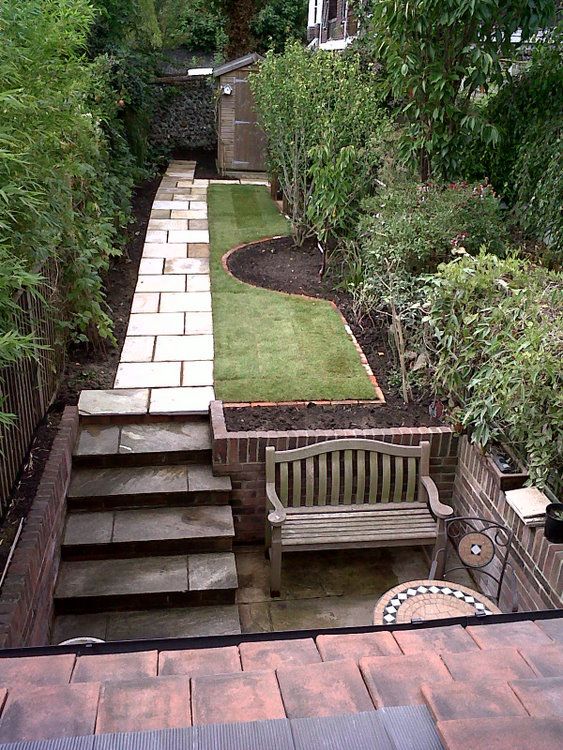
Dean Herald-Rolling Stone Landscapes
4. Mask the boundaries - use plants of different sizes and shapes to divert attention from the boundaries of the site. Accentuate the far border to visually bring it closer. Also divide the long plane of the fence with plants.
SEE ALSO…
Decorative Fence: How to fence off strangers beautifully
Dean Herald-Rolling Stone Landscapes
Combine different types of paving, complement them with lawn and ground cover plants. Use this technique not only on horizontal, but also on vertical planes. A variety of textures, the use of murals, panels, and lamps will break an extended fence into separate fragments and make the elongated area more harmonious.
YOUR TURN…
What do you think are the main advantages and disadvantages of stretched sections? What strategy helps to compensate them most effectively?
Lot Narrows: Lot Narrow Space Design, Photos and Landscaping Ideas
Narrow spaces can appear not only in small lots.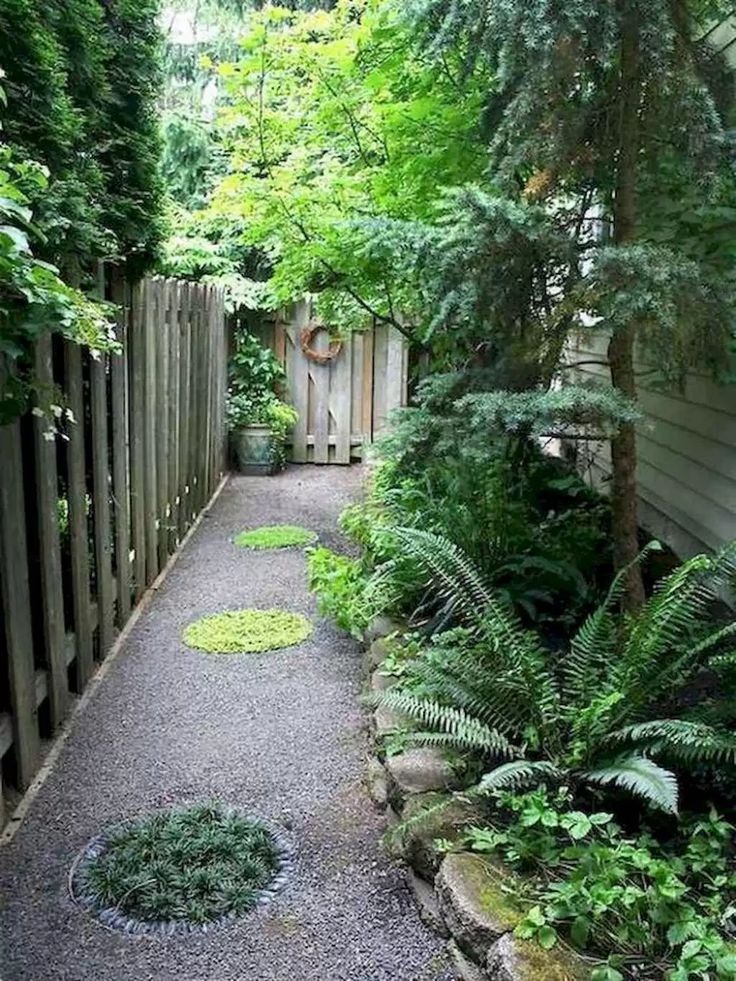 They occur when a country house or outbuildings are located close to the fence or at a short distance from each other. This placement can be convenient on the scale of the site, as it allows you to open a wider view of the rest of it and apply more efficient zoning.
They occur when a country house or outbuildings are located close to the fence or at a short distance from each other. This placement can be convenient on the scale of the site, as it allows you to open a wider view of the rest of it and apply more efficient zoning.
Often a cramped long yard adjoins a house in a townhouse development or is formed involuntarily during the renovation process. As a result, narrow and extended closed zones appear on the site, which are used as economic, and often the main passages. However, they can perform other functions, especially in case of an acute shortage of space, when you want to use literally every centimeter. Our tips will help you visually transform a narrow space and use it to the maximum advantage.
Notting Hill Gardens | Design Build Construction
Diversify monotony
Monotony is the main problem of such places. Clamped between two blank walls, the elongated and narrow passage looks gloomy and dark, even if its width is not quite small. To destroy the seeming impression of its infinity, it is worth diversifying the same surfaces.
To destroy the seeming impression of its infinity, it is worth diversifying the same surfaces.
Decorate
Decorate a fence or wall with a painting. Use the trompe l'oeil effect - the illusion of three-dimensional space, which was used by the masters of antiquity. Depict an expanding perspective or dilute the monotony with a number of painted windows.
However, it is not necessary to follow realism at all. Abstract painting and bright graffiti can transform the space. Remember that in childhood everyone was an artist, and entrust this dull corner to little creators. Children will be happy to put their talents into practice and gain valuable experience in implementing their own project.
SEE ALSO...
All in the garden: Important tips for children's play in the garden
If you are not ready to make a mural, hang the images in frames. Use materials suitable for the outdoors (this could be advertising printing technology or weatherproof wood paints), or set up a temporary exhibition.
Creative Gates Inc.
Organize the passage rhythmically
Contrast the monotony of the rhythm. Use alternating vertical elements: columns, pilasters, decorative lattices. If you are just planning to build a fence, instead of a uniform extended plane, alternate sections of different colors or materials. Accentuate the supports: let them protrude slightly and differ in finish. For example, combine stone and wood - their neighborhood looks noble and expressive. Functionally, the fence posts are placed at regular intervals, but this is not necessarily the rule. You can decorate the fence with pilasters that will not carry a supporting load, but rhythmically diversify the long plane.
Folia Horticultural + Design
Combine materials
This move will help both rhythmic organization and decoration of the space: combine several materials in one plane.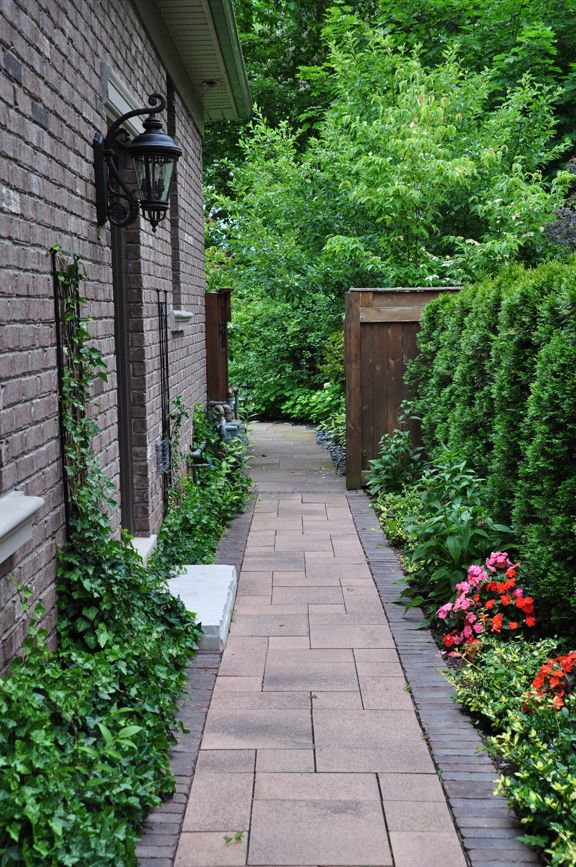 This applies to the walls, as I wrote above, but also to the covering of the track. Use tile or wood with pebbles. Tiles are best laid at intervals, rather than a continuous sheet, to create a fractional rhythm. This will help further divide the space.
This applies to the walls, as I wrote above, but also to the covering of the track. Use tile or wood with pebbles. Tiles are best laid at intervals, rather than a continuous sheet, to create a fractional rhythm. This will help further divide the space.
Irregularly shaped materials will distract from the geometry of space: “torn” natural stone or geometric concrete slabs.
Tip: If decking is used, lay it across the path or diagonally. Or - with small dice deck laying to create a colorful pattern without a pronounced direction.
Read also ...
Illusion Illumination: 10 ways to visually expand the garden
Mosaic Gardens
Break into segments
so that the narrow passage does not seem endlessly long, divide it into parts, change the layout of: set the decorative arc gates. Let them not carry a functional load, but they will help to visually interrupt a long dull corridor - it's great if these zones are not the same. The difference can manifest itself both in length and in design. But still, they should not be made completely separate - they should be a logical continuation of each other.
The difference can manifest itself both in length and in design. But still, they should not be made completely separate - they should be a logical continuation of each other.
Another way to visually divide the space is to use screens. They should not block the passage, but only divide it into planes. If the space is not extremely narrow and the width allows, screens will help create separate zones on a small patch.
Tyler Chartier Architectural Photography
Change the Geometry
The curved, floating shapes of these blank metal fences, combined with twisting shafts, distract attention from the size of the space and the overhanging height of the fences, destroying its isolation. Diagonals and zigzags will help create a similar effect.
LANDSCAPE SOLUTION SERVICE JSC
Winding path
Make the path slightly winding. This technique can also be used in very narrow aisles: create the illusion of bends in the path due to the smooth line of its edges. Curving line looks more interesting and adds a sense of variety.
Curving line looks more interesting and adds a sense of variety.
An alternative to a straight continuous path will be natural stone, tiles or saw cuts laid apart. Fill the gaps between them with pebbles, mulch, moss, or ground cover plants.
SEE ALSO…
Good way: What to consider when planning paths on the site
Place accents
Another affordable way to visually break up a monotonous space is to place accents along its length. These can be sculptural elements chosen in accordance with the style of the site, flowerpots with plants or even a fountain. And if the width allows - a beautiful bench. A classic bench with a curved back while maintaining the aisle can be installed if the width of the zone is at least 180-200 cm. However, a simple seat of laconic forms will require much less space and at the same time may look no less decorative.
LANDSCAPE SOLUTION SERVICE JSC
Emphasize the end
If a narrow passage ends in a dead end or a turn and you only see a wall ahead, emphasize it.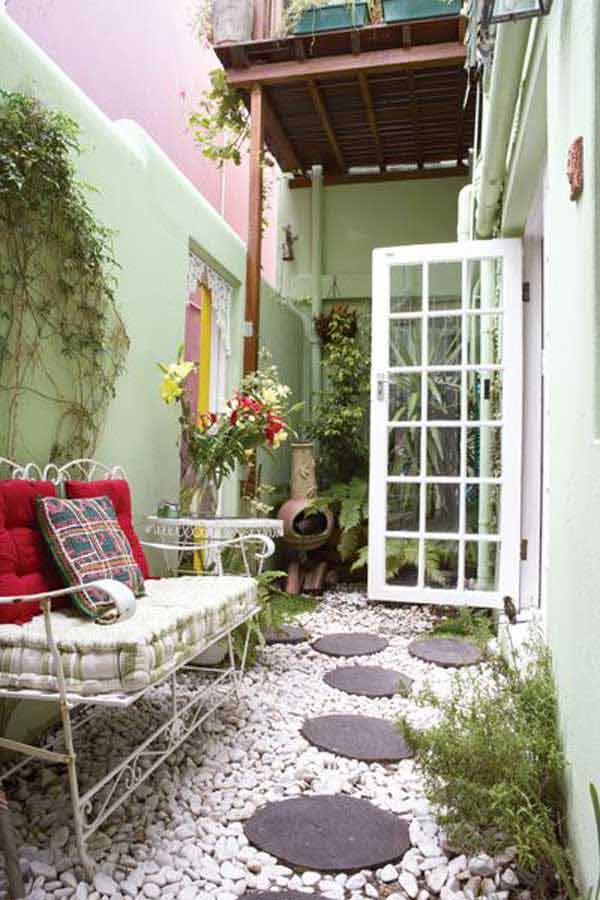 Highlight the end of the passage with color or bright painting - this will visually bring the wall closer. Or place a decorative element there: an ornamental lattice, a relief, a sculpture, which, drawing the eye, will help create an approach effect. If the light and width allow, plant a shrub there or plant a standard tree in a container. Dereni ( Cornus ), honeysuckle ( Lonicera ), callinwort ( Physocarpusopulifolius ) and snowberry ( Symphoricarpos ) will grow even in shady places, and their size is easily controlled by pruning.
Highlight the end of the passage with color or bright painting - this will visually bring the wall closer. Or place a decorative element there: an ornamental lattice, a relief, a sculpture, which, drawing the eye, will help create an approach effect. If the light and width allow, plant a shrub there or plant a standard tree in a container. Dereni ( Cornus ), honeysuckle ( Lonicera ), callinwort ( Physocarpusopulifolius ) and snowberry ( Symphoricarpos ) will grow even in shady places, and their size is easily controlled by pruning.
Or place an upholstered sofa against the wall, which will beckon with its relaxing calmness and turn a narrow enclosed area into a secluded place to relax. Use outdoor upholstery or wicker furniture made from natural or artificial rattan. Place a miniature coffee table next to the sofa or mount it on the wall.
TY LARKINS INTERIORS
Plants
A narrow space is no reason to forego plants.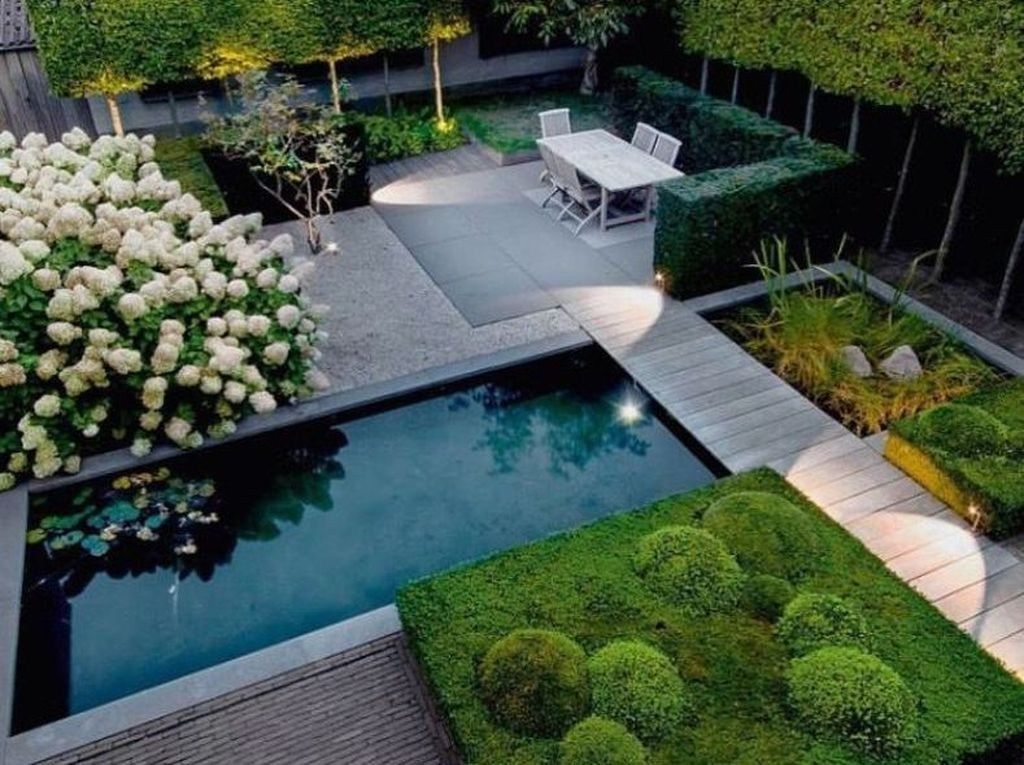 On the contrary, they will help decorate and structure a boring passage. A row of low container plants, as in the photo, will help to horizontally divide a high fence, eliminating the pressure. Smooth bends of vines diversify the strict geometry of straight lines. By masking one of the walls with thick greenery, you will destroy the feeling of isolation, and vertical trunks will create a beautiful rhythmic pattern. Depending on the available width and light, you can choose one of the ways to place plants in this area.
On the contrary, they will help decorate and structure a boring passage. A row of low container plants, as in the photo, will help to horizontally divide a high fence, eliminating the pressure. Smooth bends of vines diversify the strict geometry of straight lines. By masking one of the walls with thick greenery, you will destroy the feeling of isolation, and vertical trunks will create a beautiful rhythmic pattern. Depending on the available width and light, you can choose one of the ways to place plants in this area.
Frank & Grossman Landscape Contractors, Inc.
Plant placement options
An excellent choice, designed specifically for narrow spaces, is growing trees and shrubs on a trellis. The essence of this method, just, is that the plant is formed in one plane and therefore does not take up much space at all in width. At the same time, this method of growing allows you to form an ornamental crown that will decorate a solid wall or fence with a green pattern. Hawthorn is perfect for trellis growing ( Crataegus ), Linden ( Tilia ), Maple ( Acer ), Apple ( Malus ).
Hawthorn is perfect for trellis growing ( Crataegus ), Linden ( Tilia ), Maple ( Acer ), Apple ( Malus ).
- Alley
This is a great way to rhythmically organize an extended space, and it's not just for wide driveways. If there is not enough space for two rows, place the trees on one side only. Plant in these places slow-growing species, trees that can be easily pruned or standard forms.
SEE ALSO…
Native birches: "Russian Beauty" is back in the game
John Davies Landscape
Karena Batstone Design
Container plants will also be good in this zone. If there is not enough space for the alley, select the entrance part with two symmetrically located trees.
- Pergola
Good news: if you have been dreaming of a pergola on your property for a long time, but could not find a place for it, a narrow passage (for example, between a house and a fence) is just perfect for this. Arrange the sloped beams going from the fence to the wall in increments of approximately 1.5 m (although the specific figure will depend on the length and width of the passage). You can lean them on fence posts or on separate columns, which, with their rhythm, will help break the monotonous plane. Or install metal arches for pergolas. Leave small plots of land near the supports or install flowerpots in which you will plant climbing plants. Parthenocissus quinquefolia (L.) Planch ). It is undemanding to soils and illumination, resistant to diseases, frost-resistant, hibernates without shelter even to the north of St. Petersburg and grows rapidly. In addition, it will delight you with decorativeness all season: in spring and summer - with ornamental foliage, and in autumn - with rapidly changing brightness of color. For more lighted areas honeysuckle honeysuckle ( Lonícera caprifólium ), which will fill your garden with a delicate aroma, and other types of climbing honeysuckles are excellent choices.
Arrange the sloped beams going from the fence to the wall in increments of approximately 1.5 m (although the specific figure will depend on the length and width of the passage). You can lean them on fence posts or on separate columns, which, with their rhythm, will help break the monotonous plane. Or install metal arches for pergolas. Leave small plots of land near the supports or install flowerpots in which you will plant climbing plants. Parthenocissus quinquefolia (L.) Planch ). It is undemanding to soils and illumination, resistant to diseases, frost-resistant, hibernates without shelter even to the north of St. Petersburg and grows rapidly. In addition, it will delight you with decorativeness all season: in spring and summer - with ornamental foliage, and in autumn - with rapidly changing brightness of color. For more lighted areas honeysuckle honeysuckle ( Lonícera caprifólium ), which will fill your garden with a delicate aroma, and other types of climbing honeysuckles are excellent choices.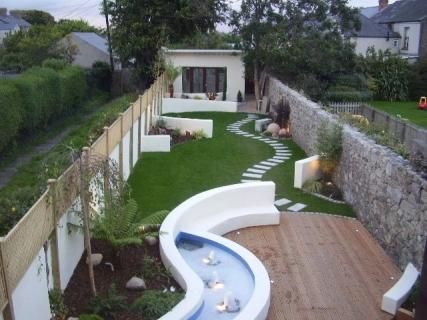
- In the shade
Narrow passages bounded by high walls are very often heavily shaded. But this does not mean that they cannot be decorated with plants. Ferns, hostas ( Hosta ), aquilegia ( Aquilegia ), woodruffs ( Galium ) will do well in the shade, but forget-me-nots ( Myosotis ), anemones ( Anemone ) and umbilicals ( ) delight with delicate blooms.
SEE ALSO…
Small but bold: Choosing plants for a small garden
TLA Studio
Accents Lighting
Playing with light
Lighting design is a versatile decorative technique that can be applied both inside and outside. Lighting can transform a boring narrow space, with its help you can implement almost all of the above techniques. Mounted on a wall or fence or built into it, lamps will help create a rhythmic pattern due to different directions and thoughtful placement.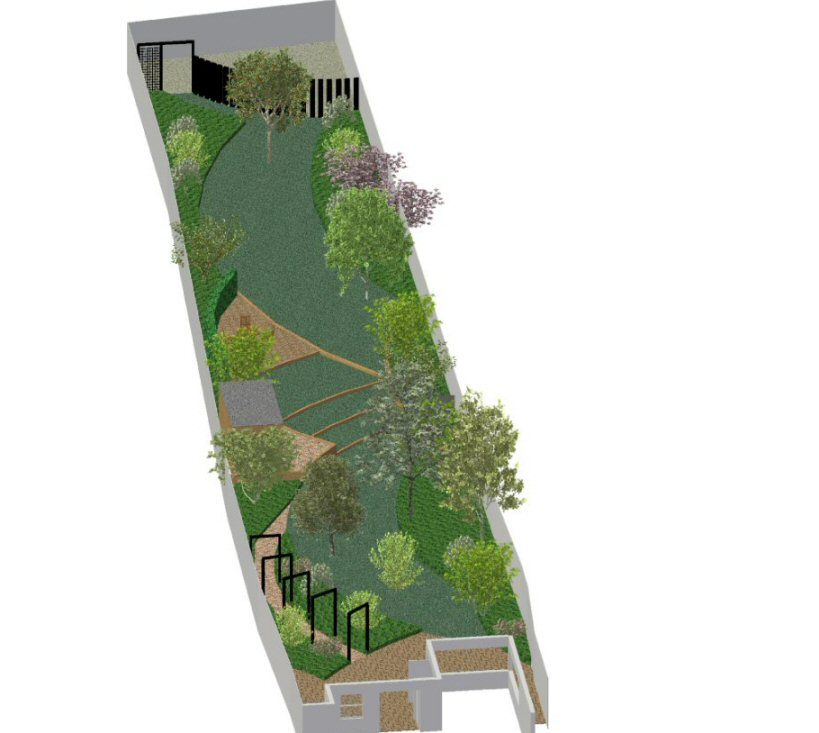 A bizarre black and white pattern will decorate monotonous walls. And the lamps themselves of the original form will become a sculptural decor.
A bizarre black and white pattern will decorate monotonous walls. And the lamps themselves of the original form will become a sculptural decor.
But even the simplest garland of light bulbs will bring a festive mood to a small space.
area design, llc.
Idea: If the garlands are strung in a narrow and long passage not parallel, but at different angles, this will divert attention from its length.
OUTHOUSE design
David Rowland Studio
Fit it all
Narrow spaces aren't just for walkways. They can find more diverse practical applications. And often their functionality is much wider than it might seem at first glance.
- Narrow cul-de-sac areas are perfect for organizing cozy seating areas with a sofa and armchairs.
- Here you can place a secluded outdoor office or workshop and a shed with tools.
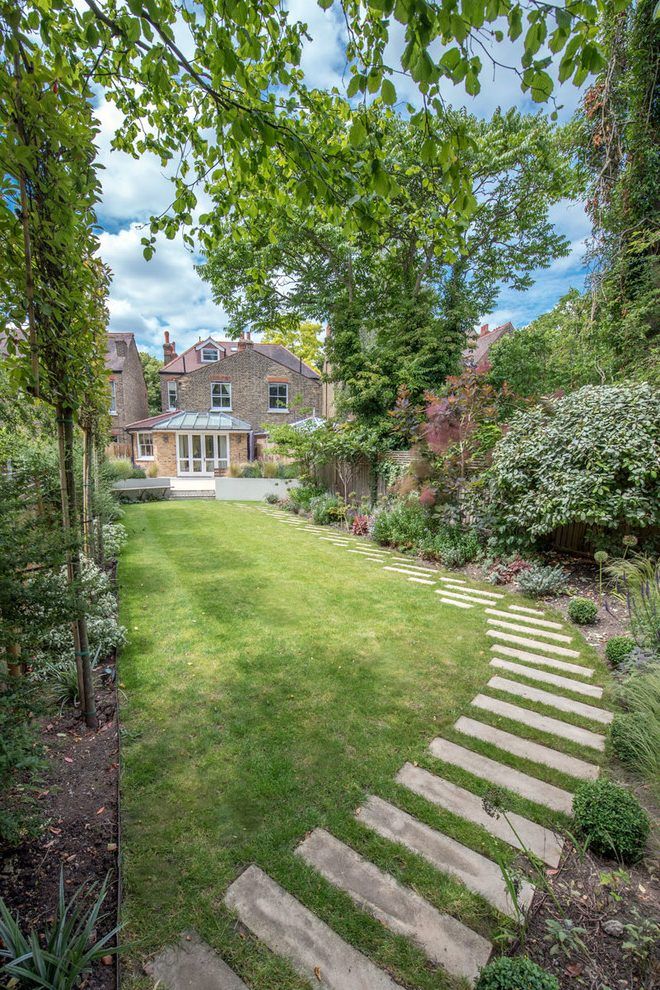
Learn more


